
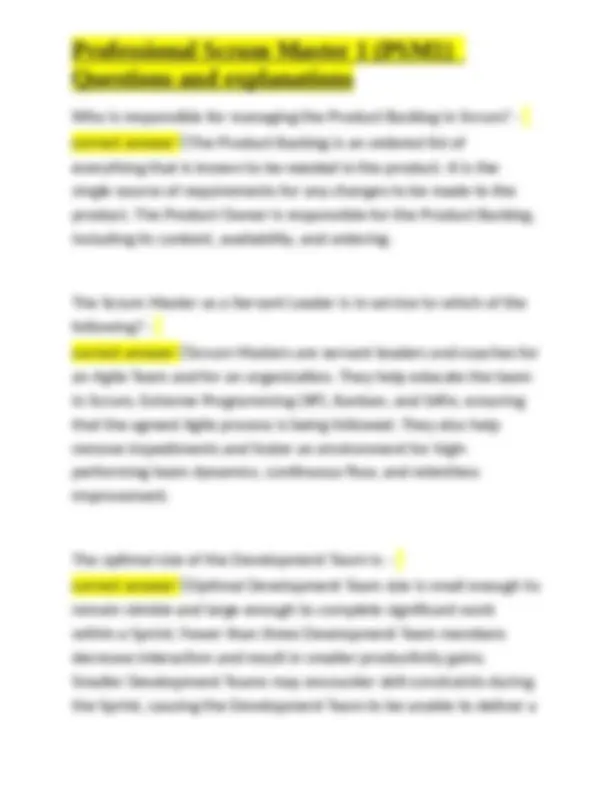
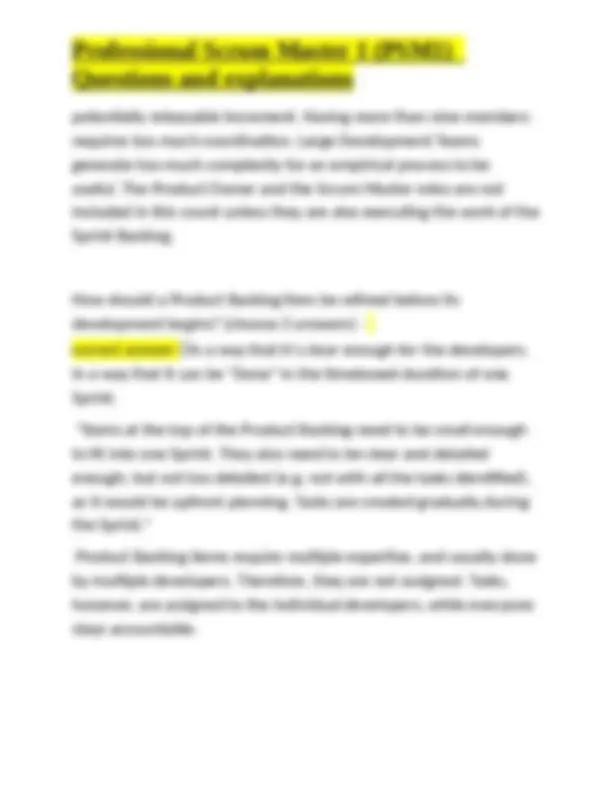
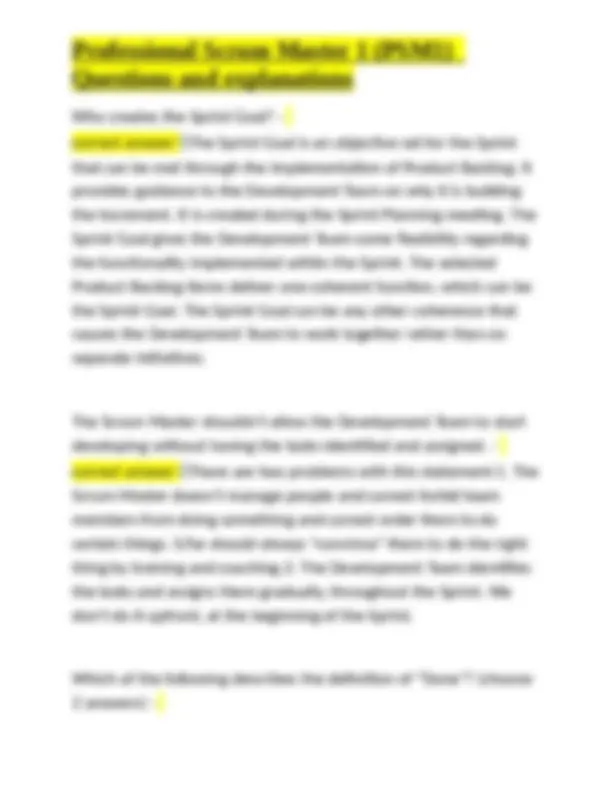
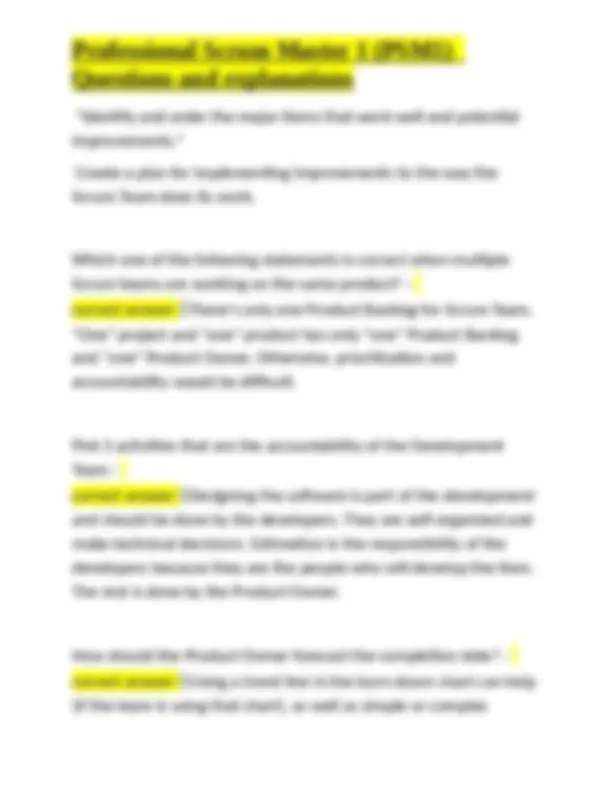
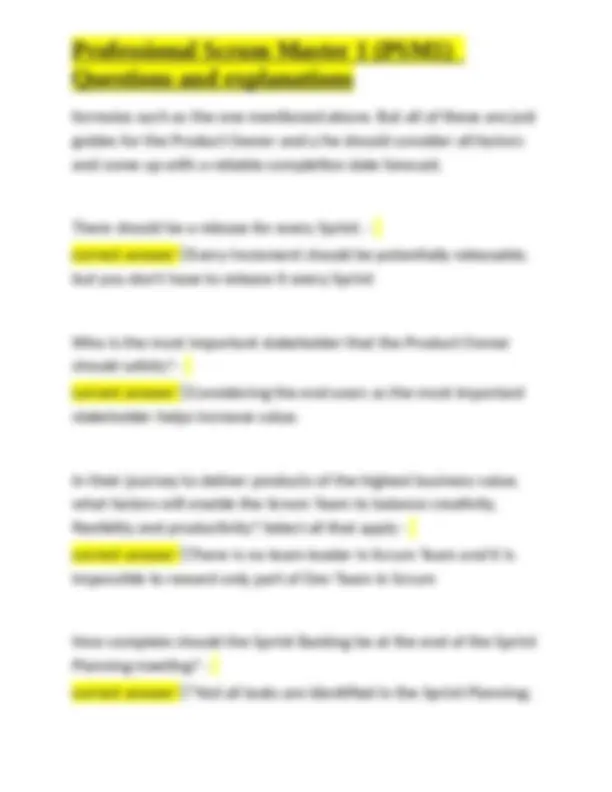
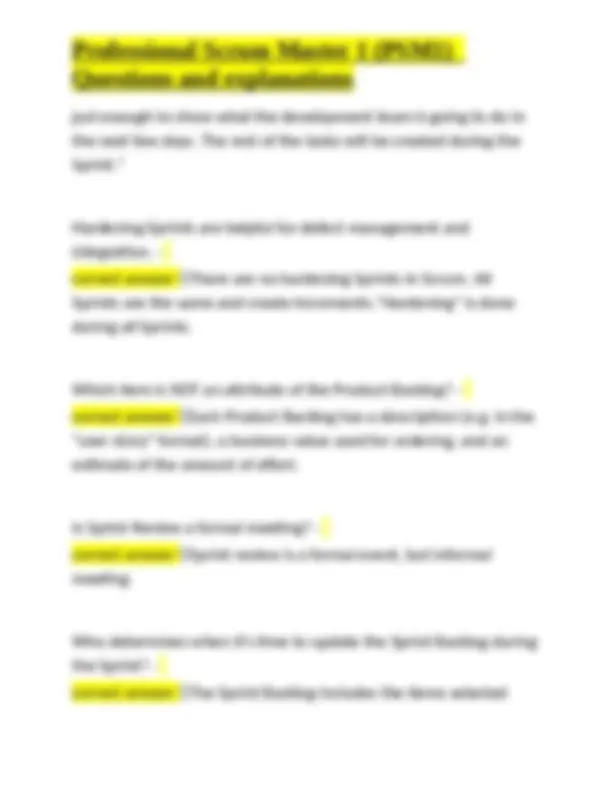
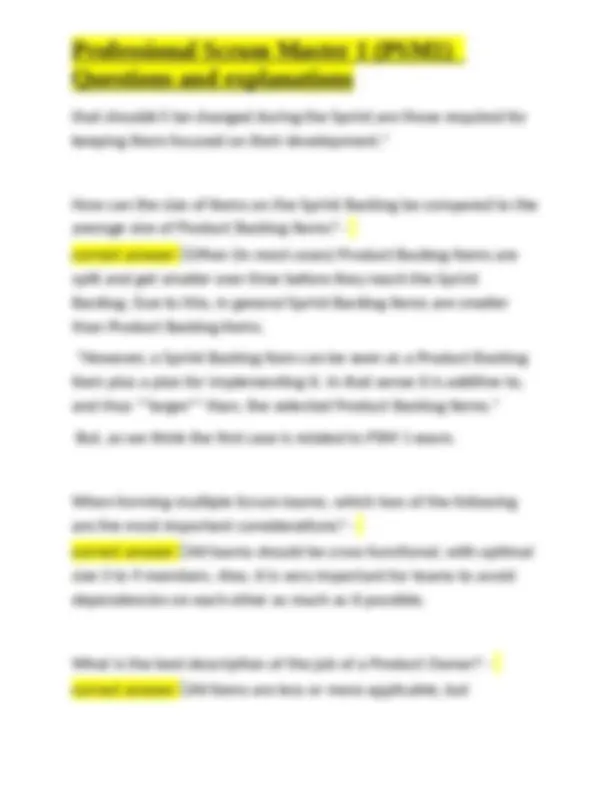
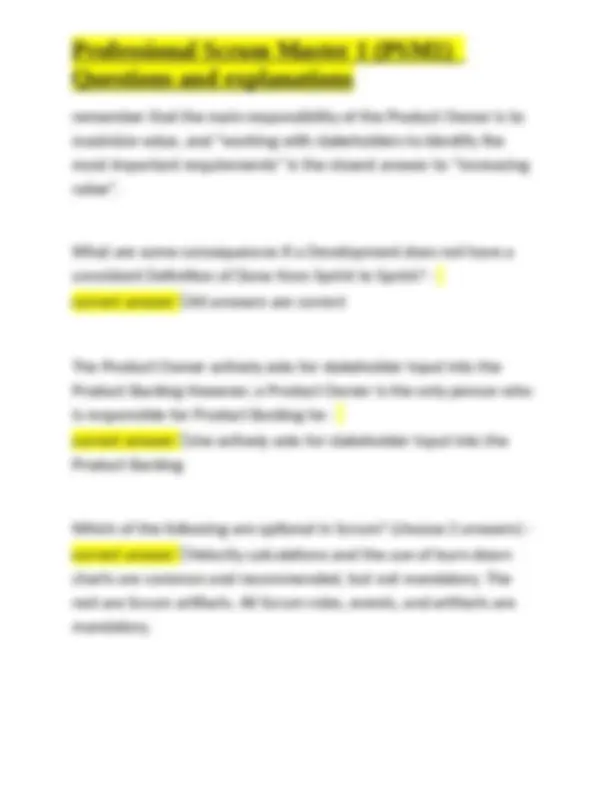
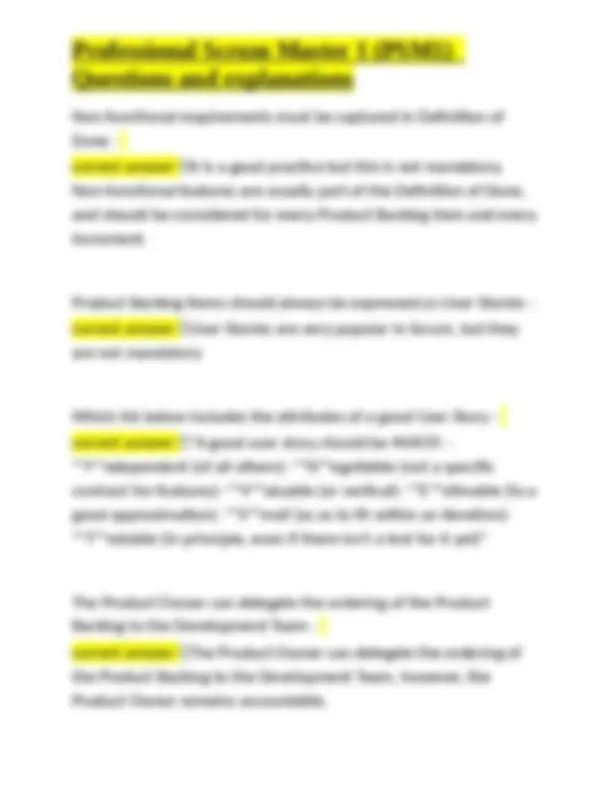
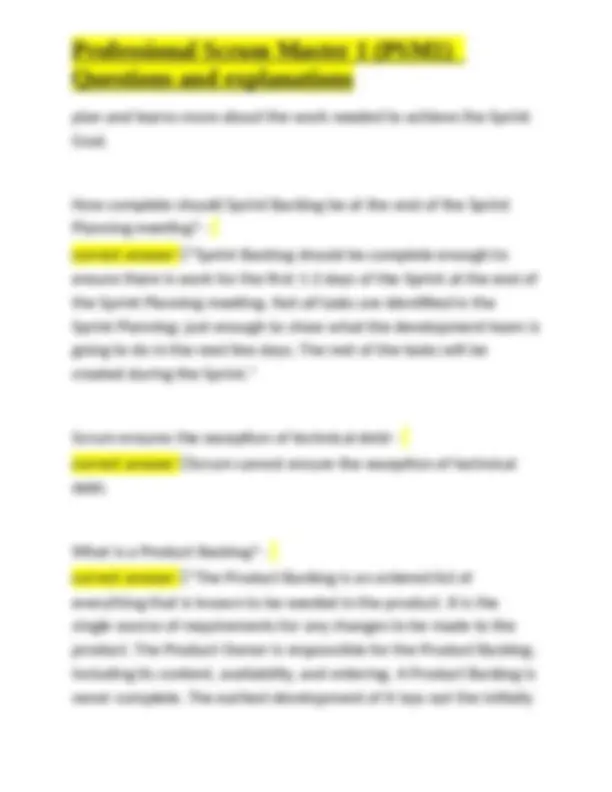
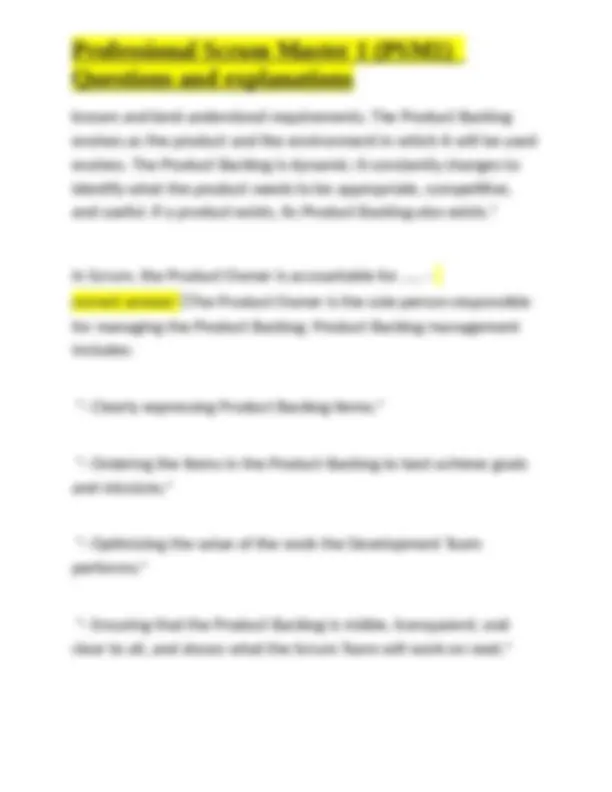
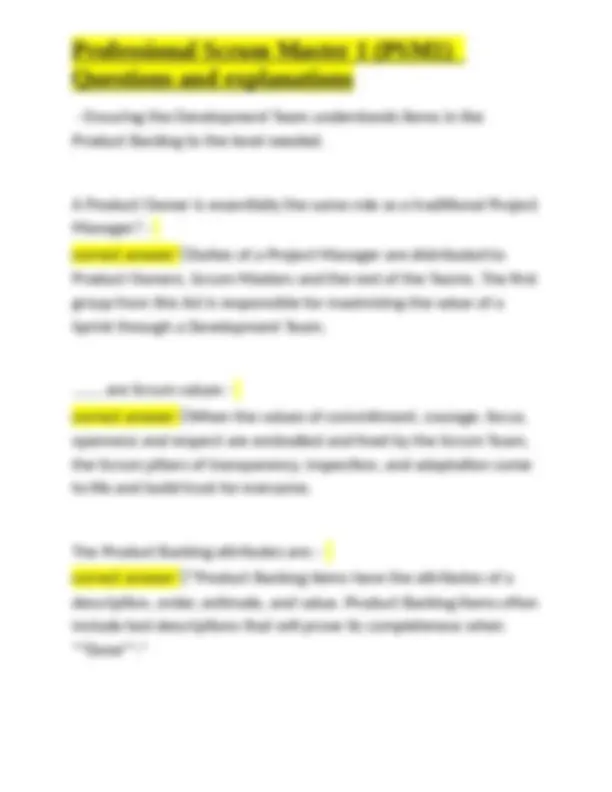
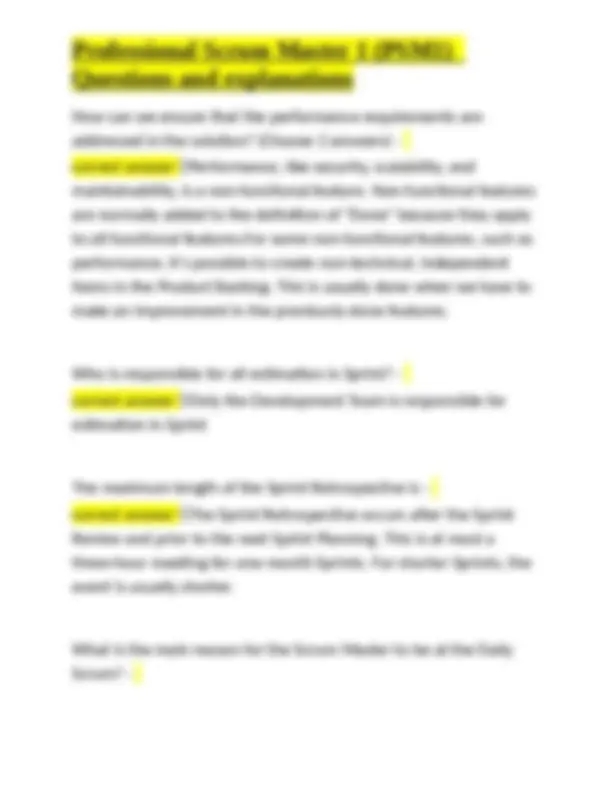
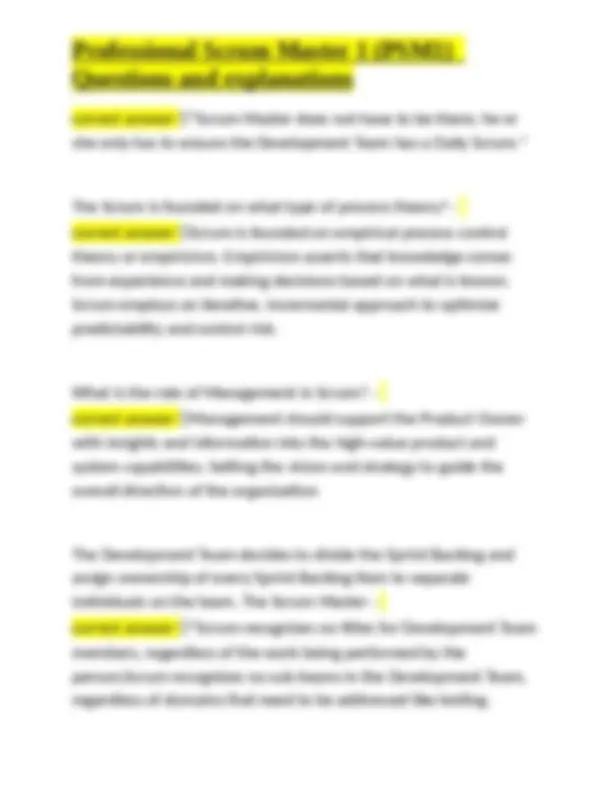
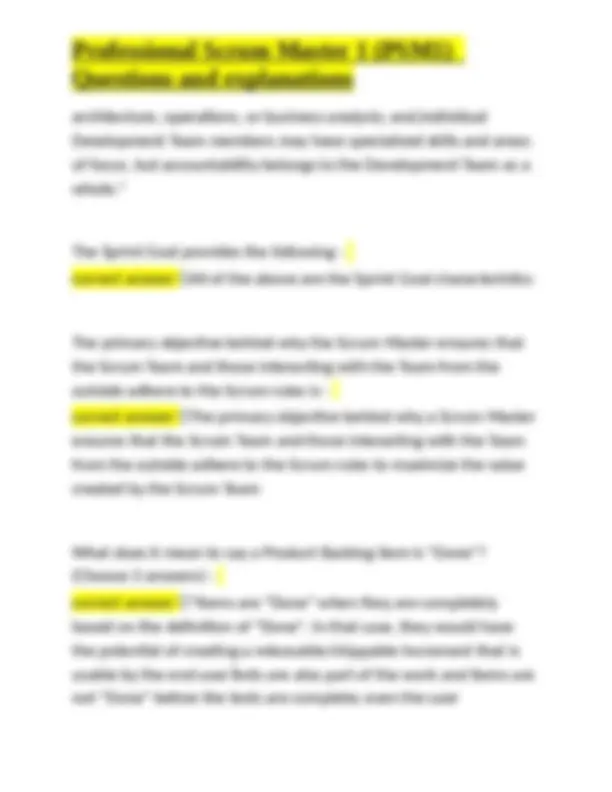
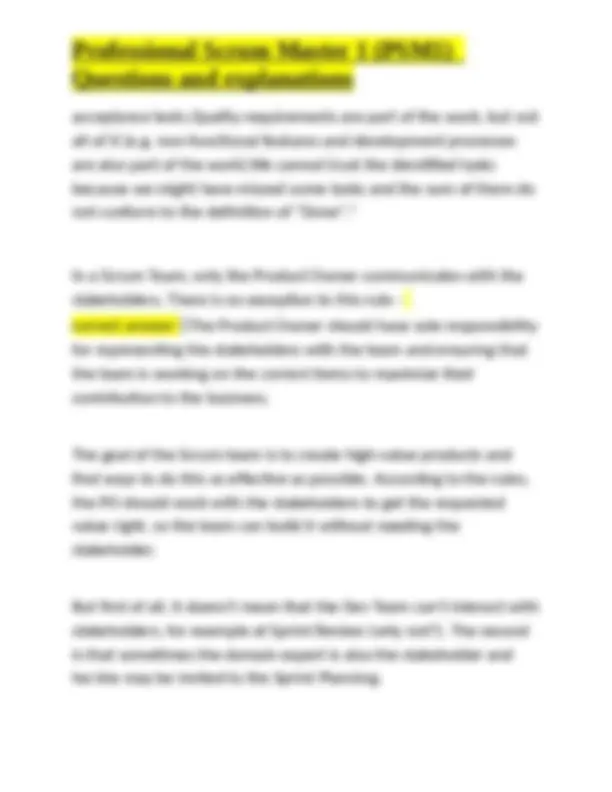
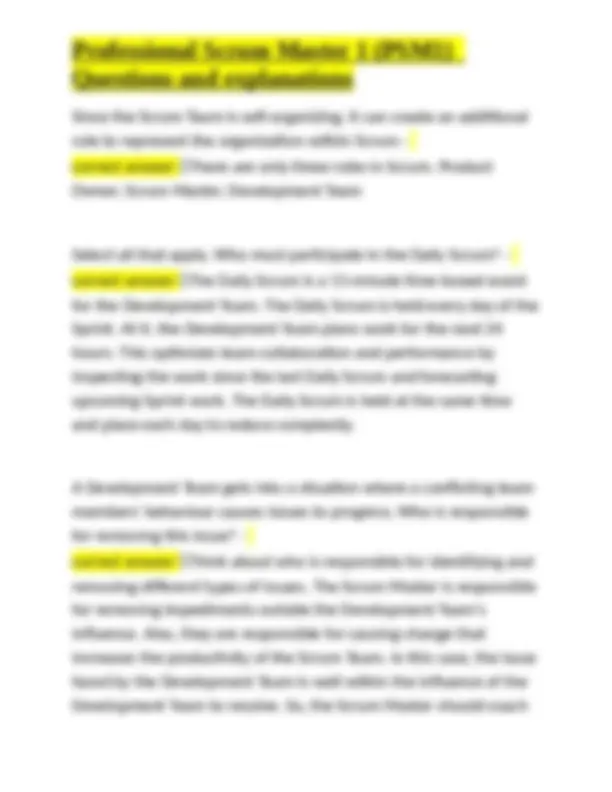
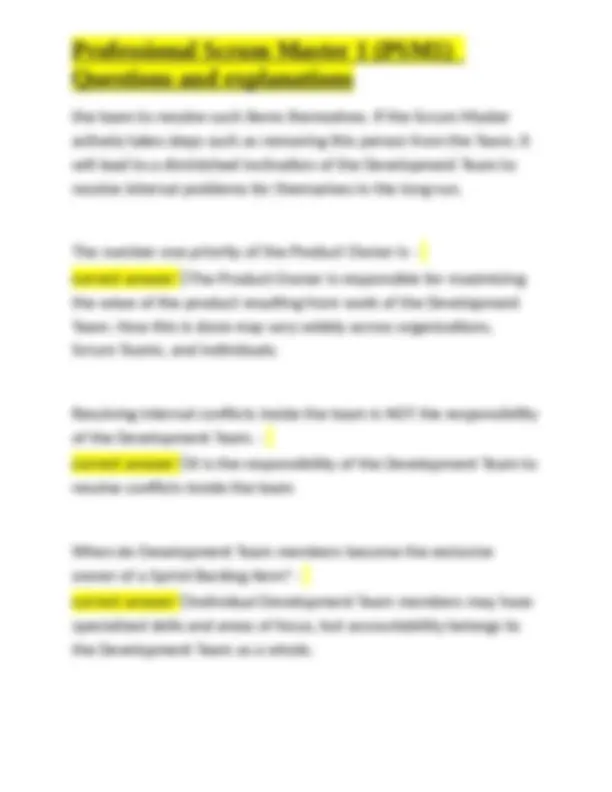
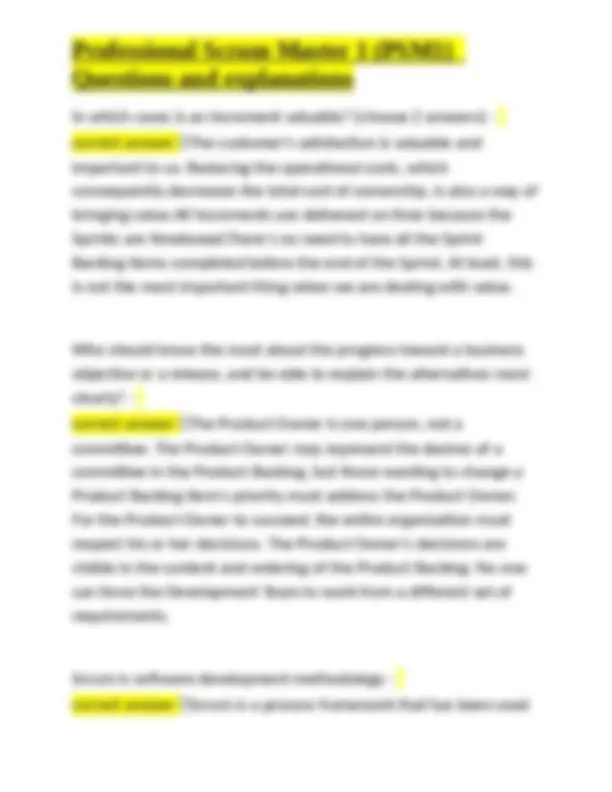
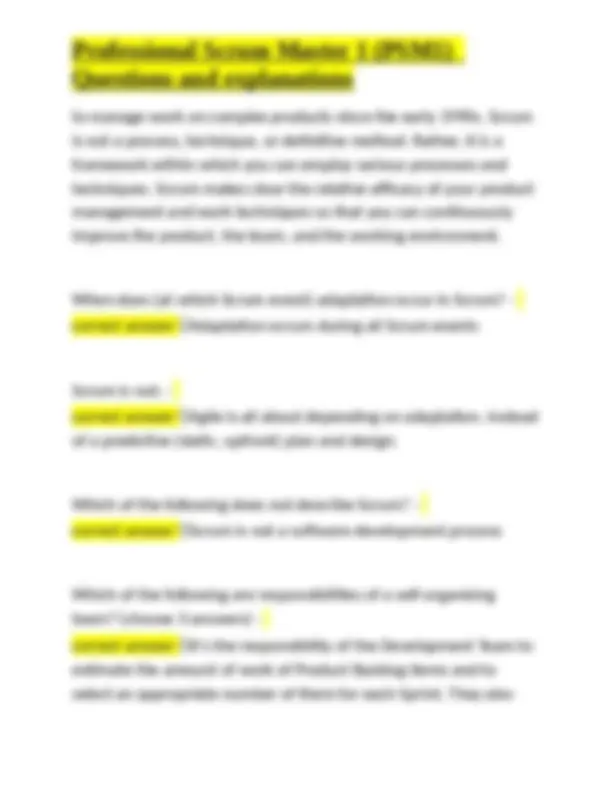
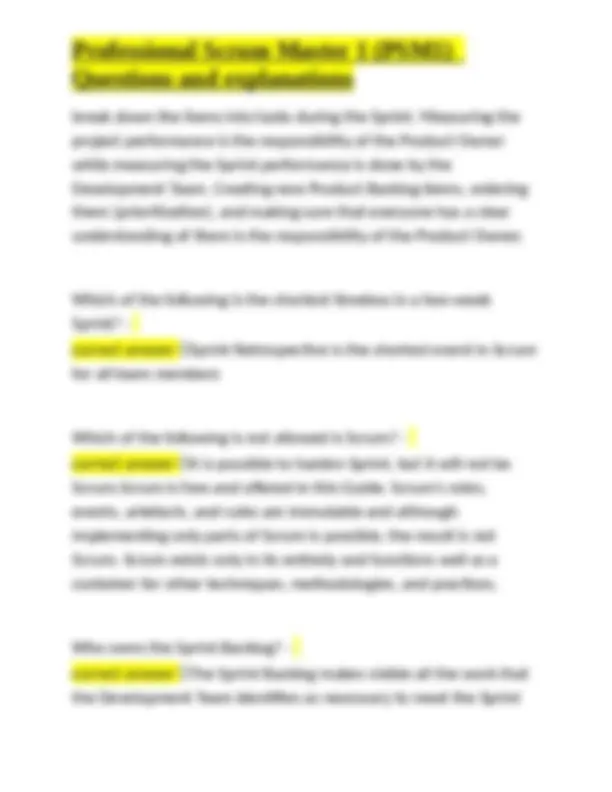
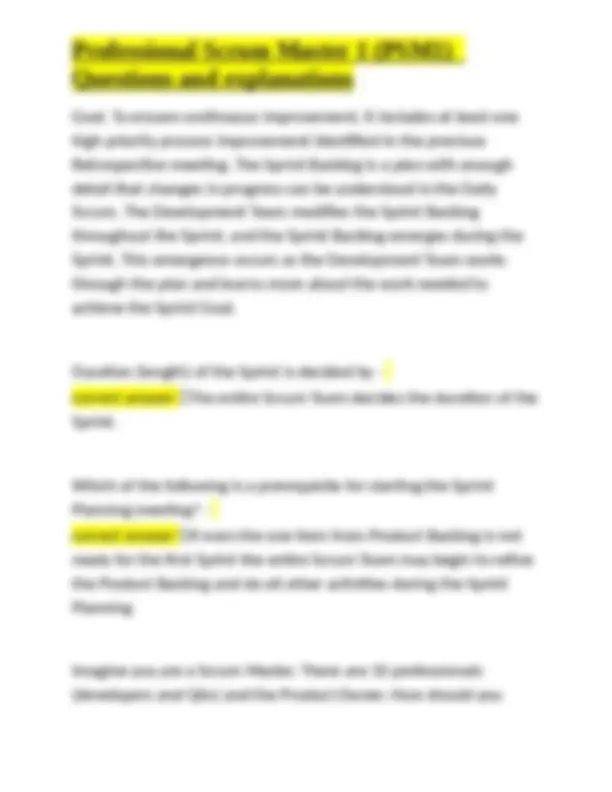
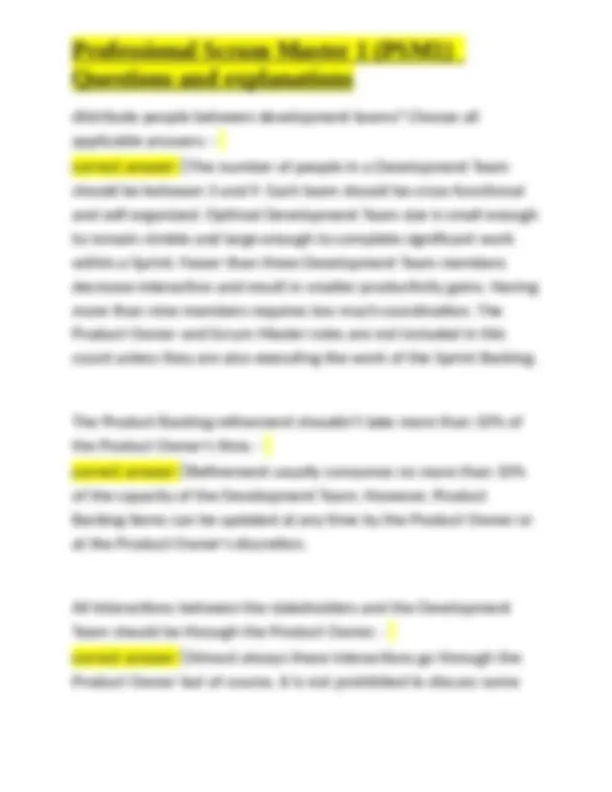
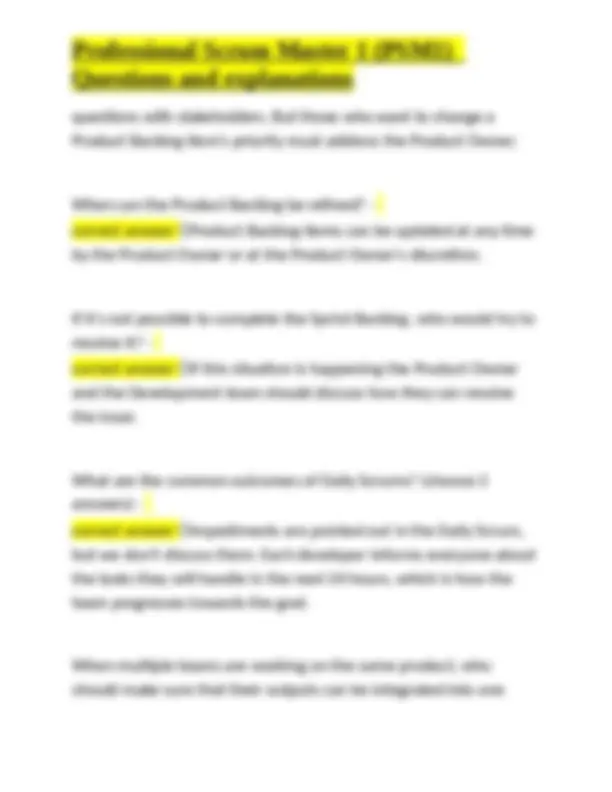
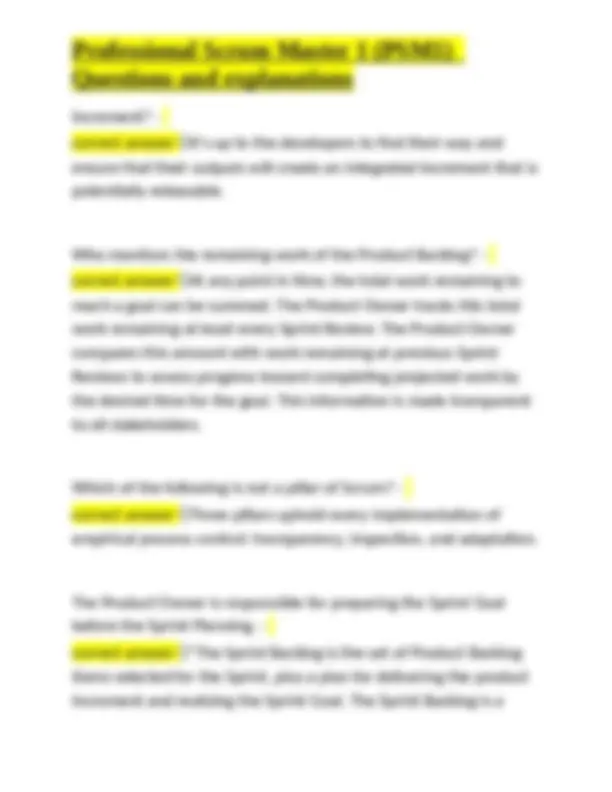

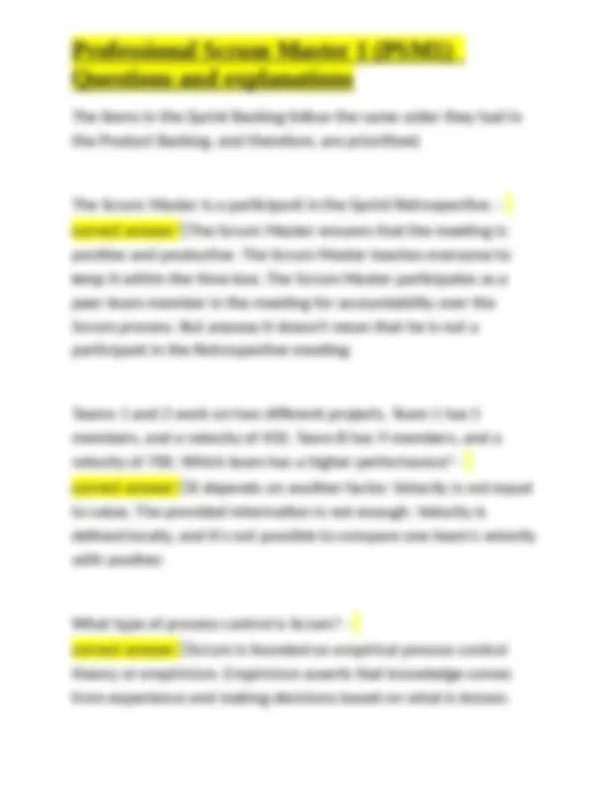
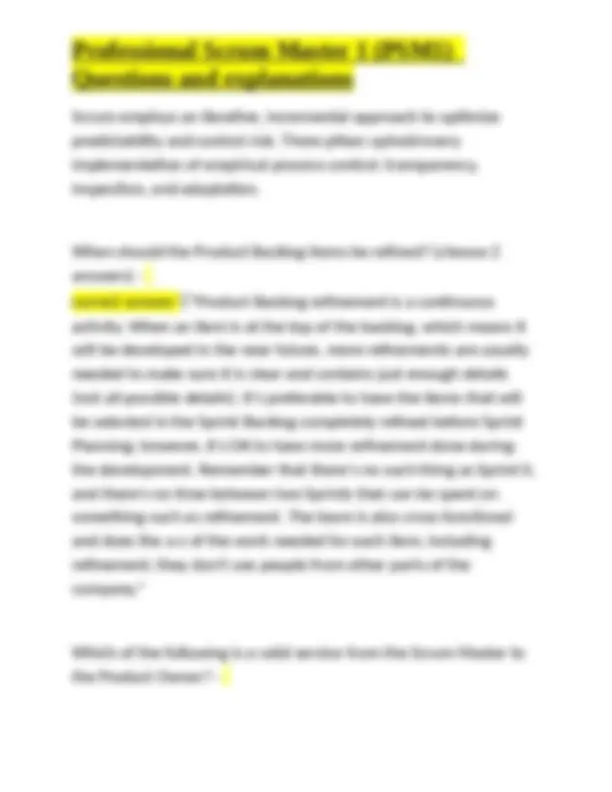
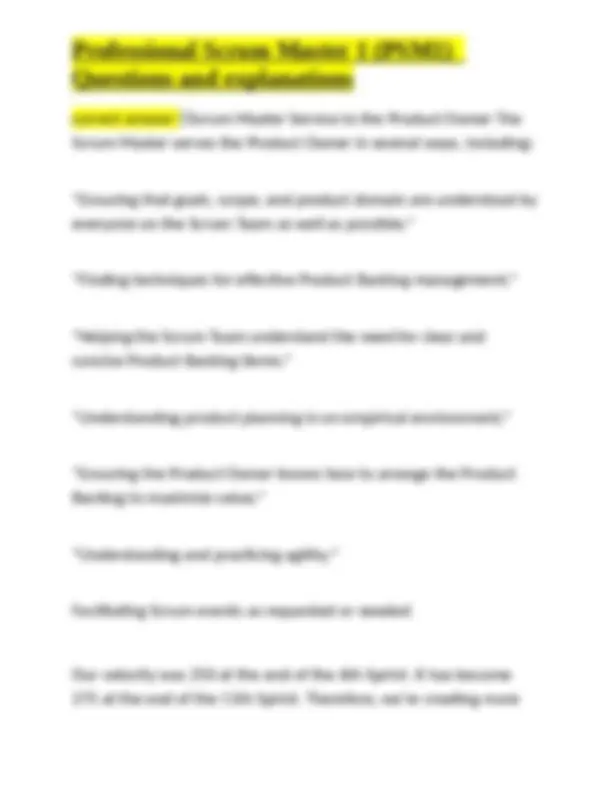
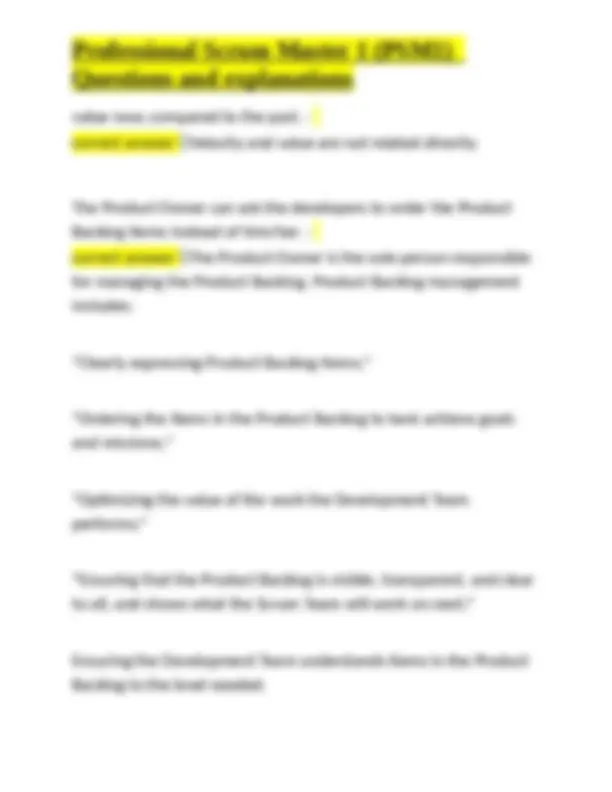
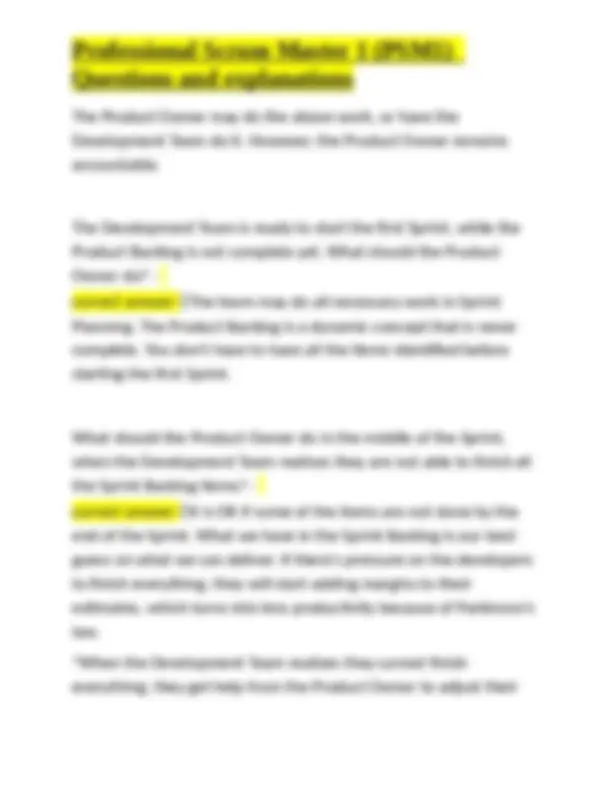
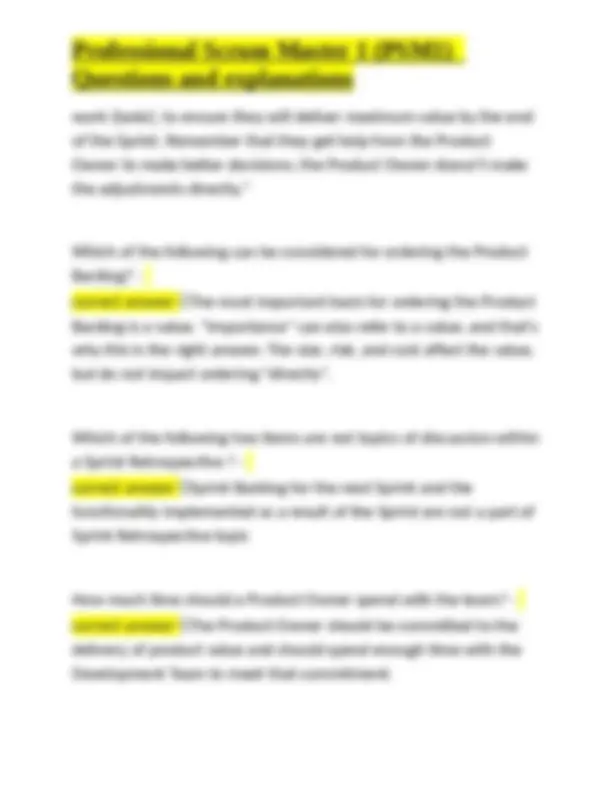
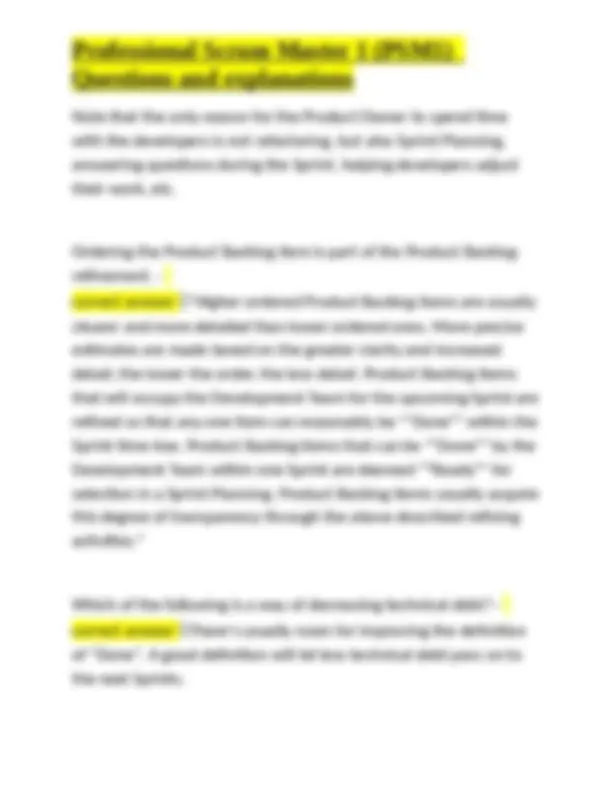
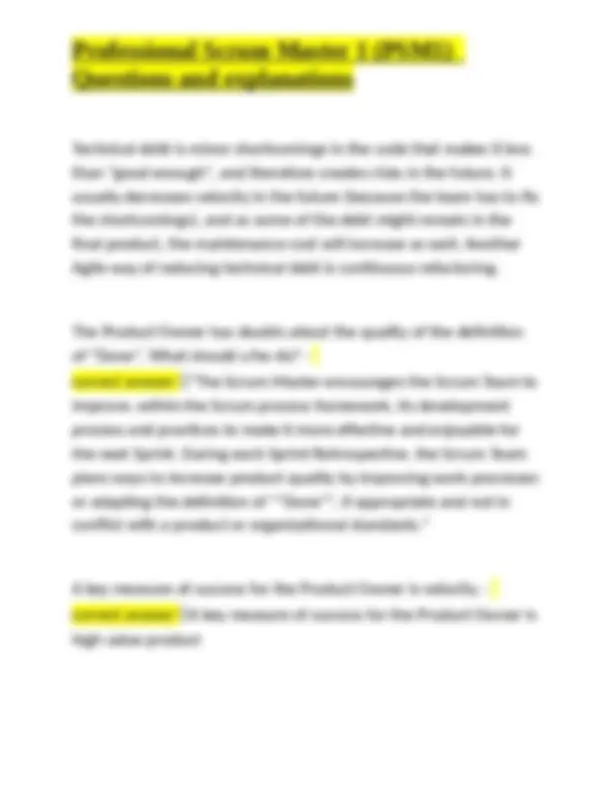
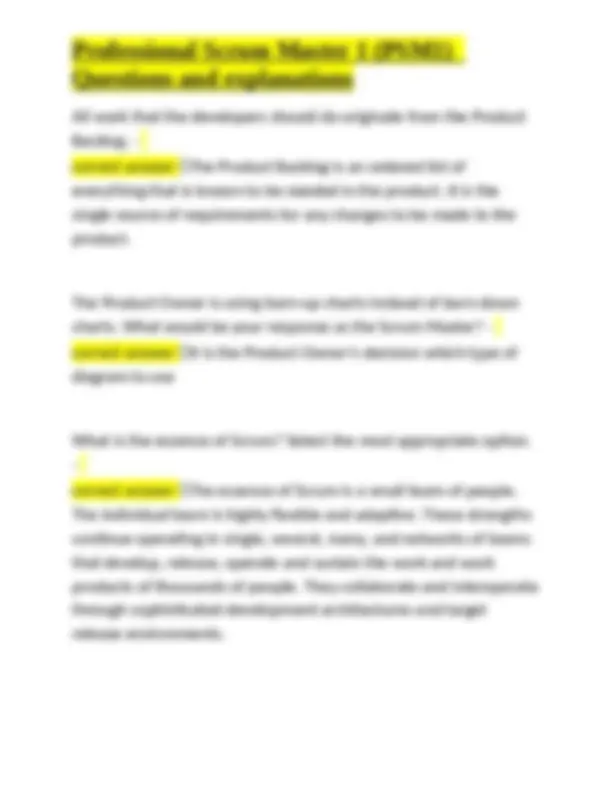
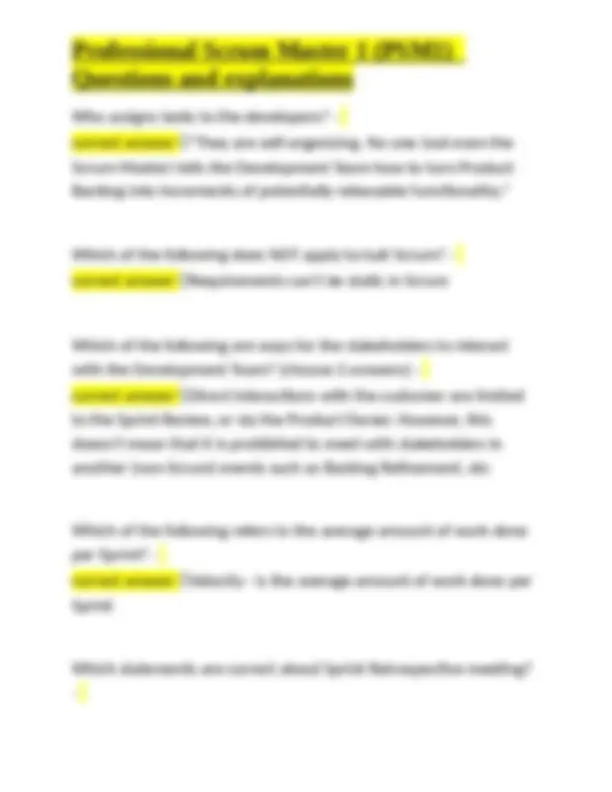
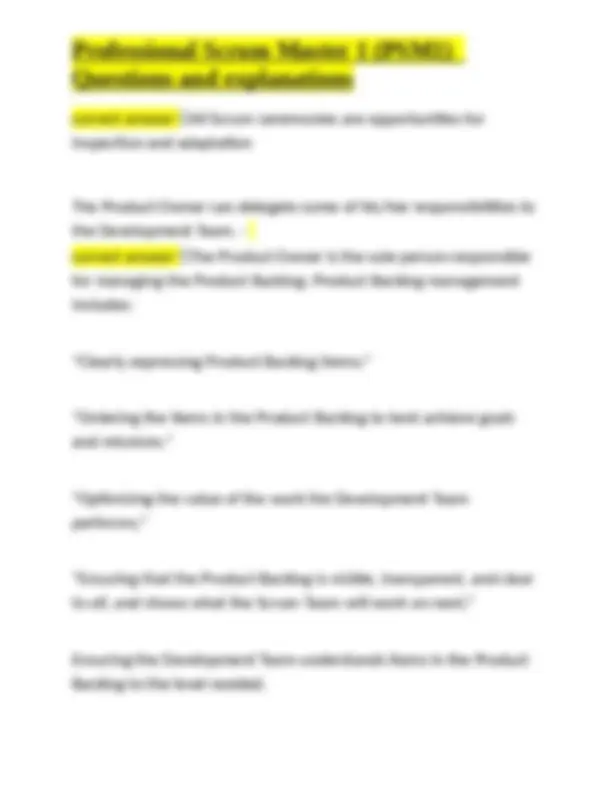
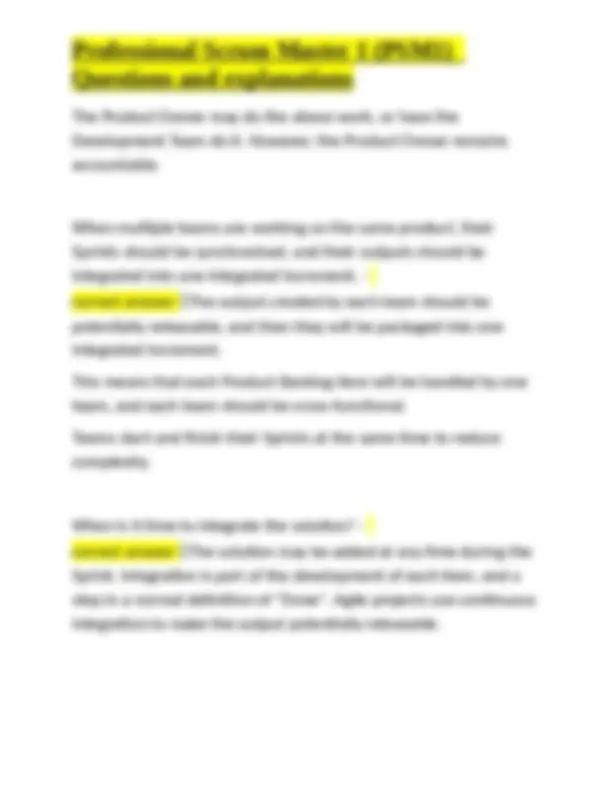
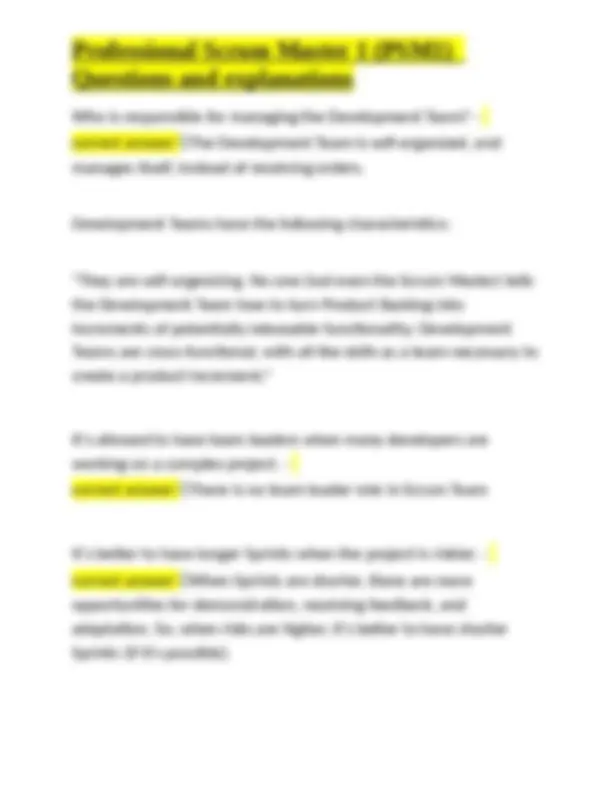
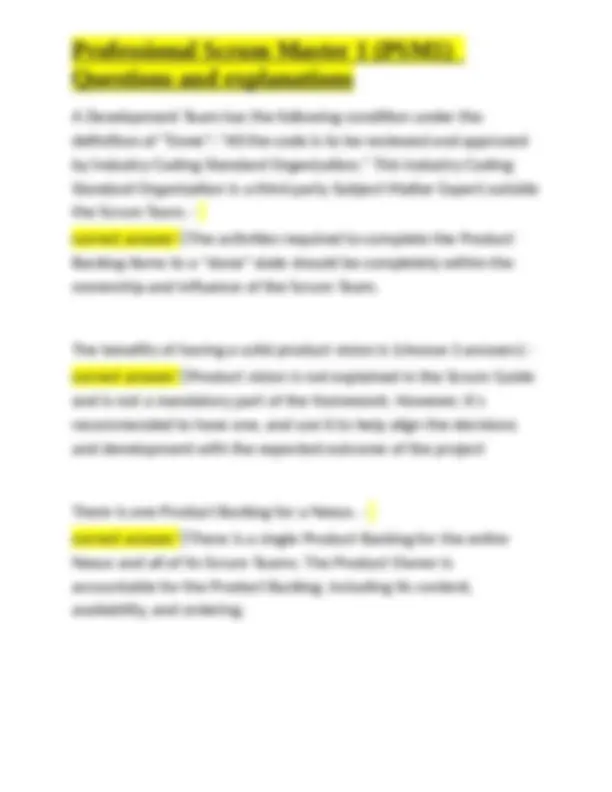
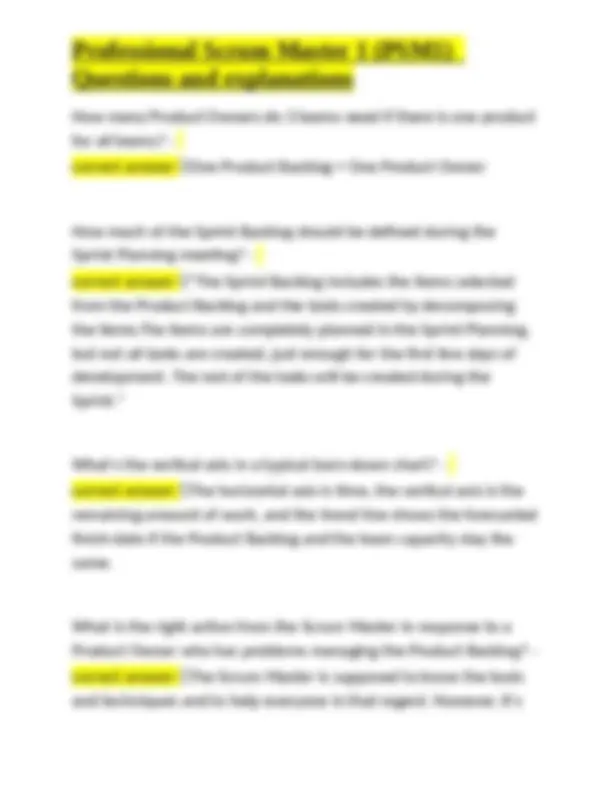
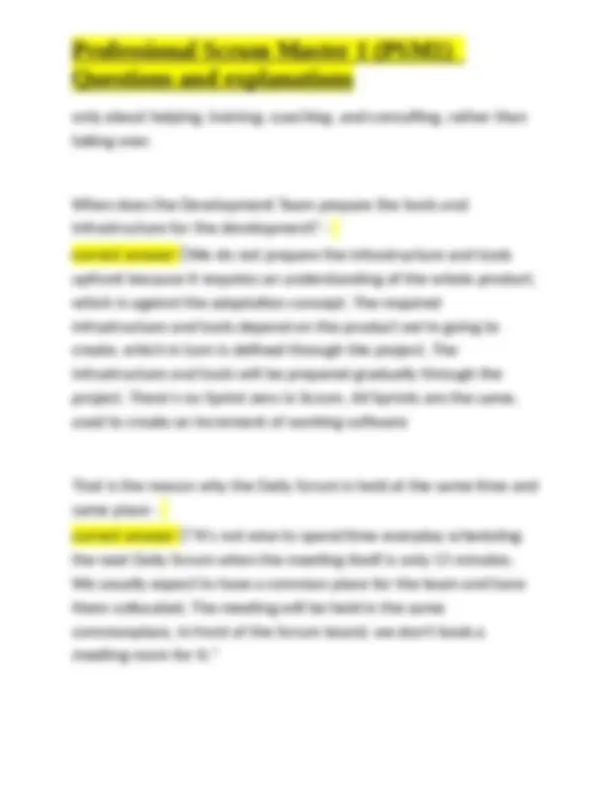
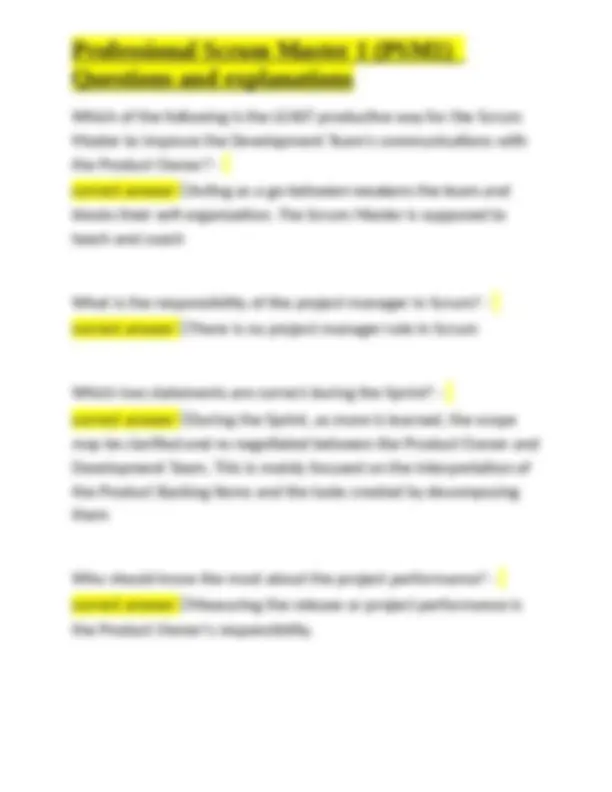
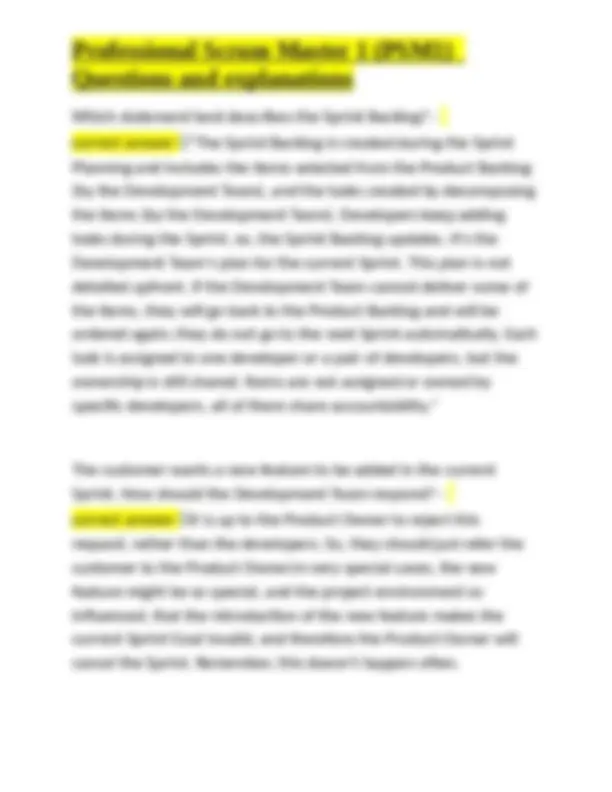
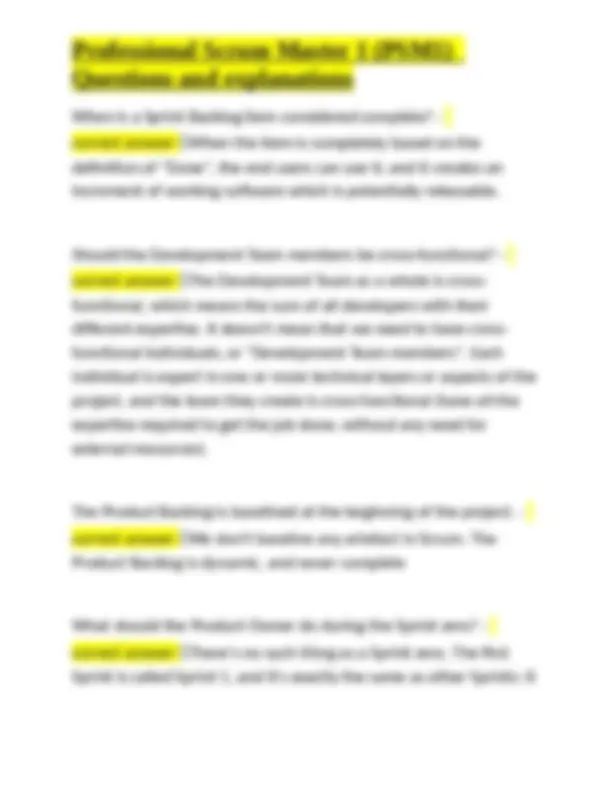
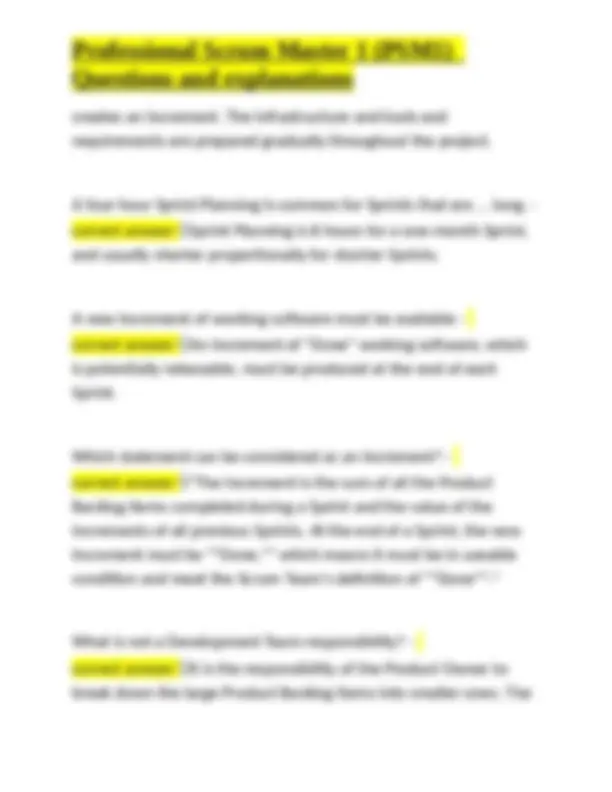
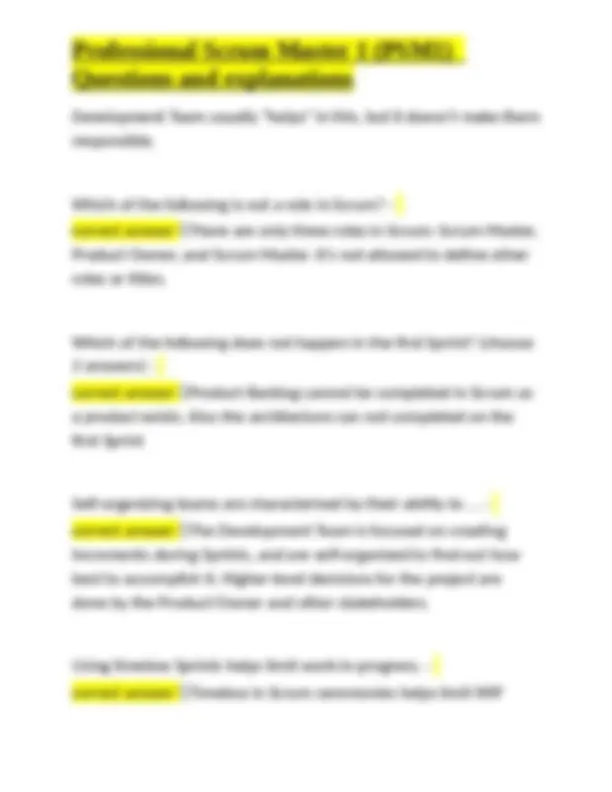
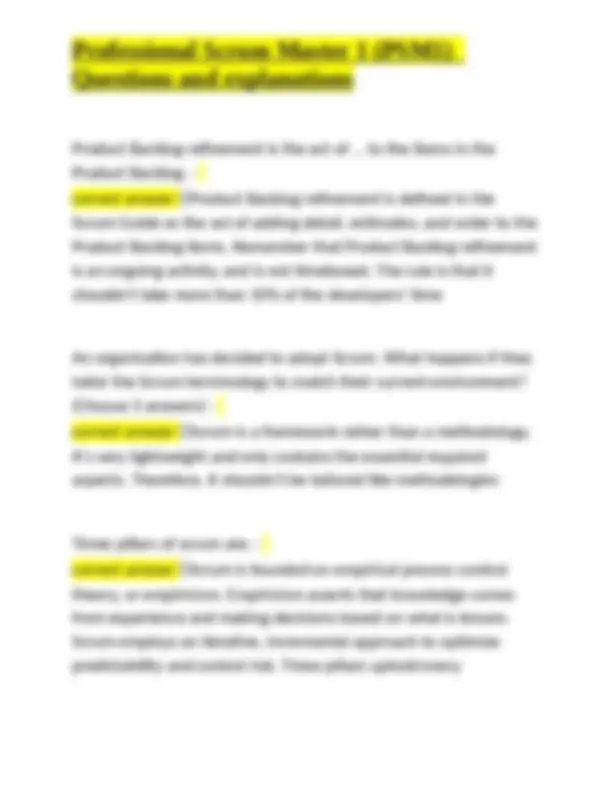
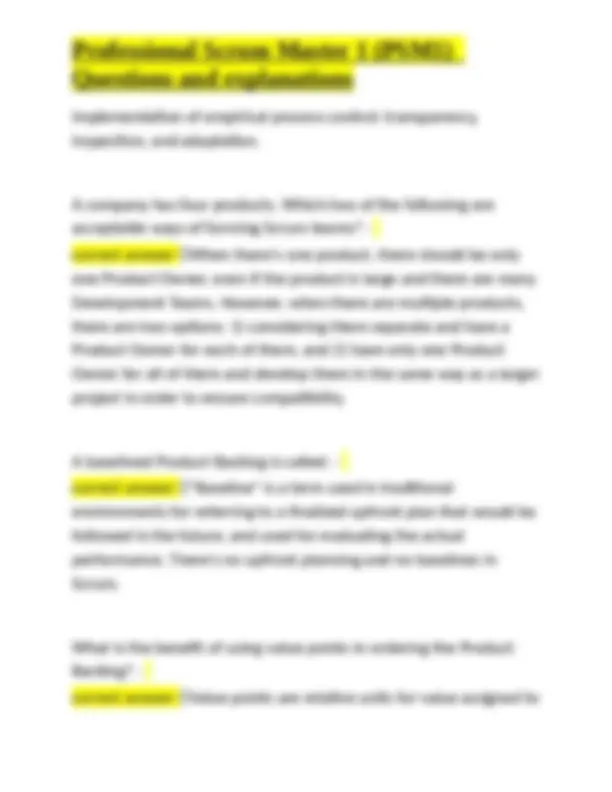
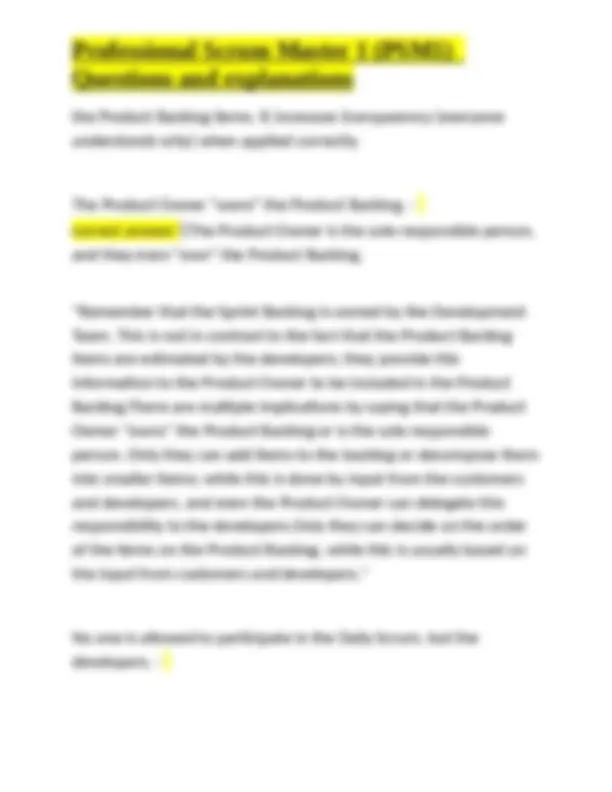
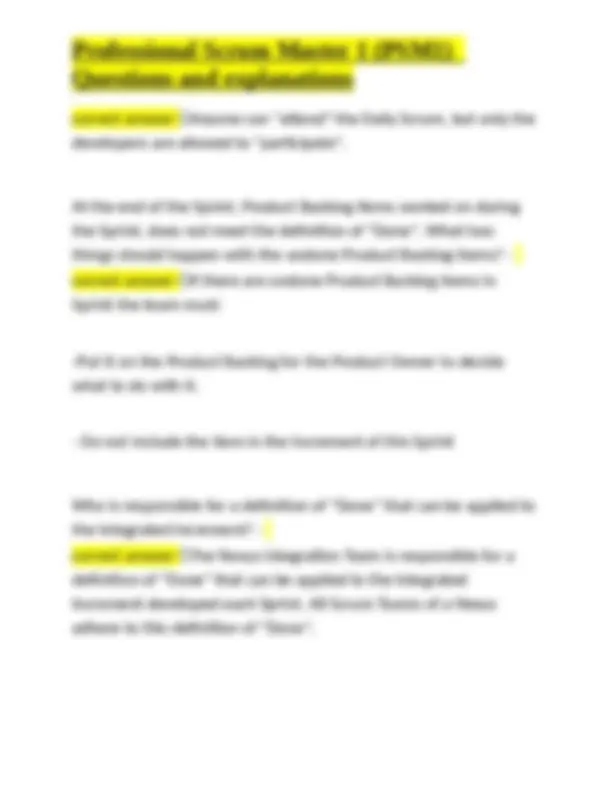
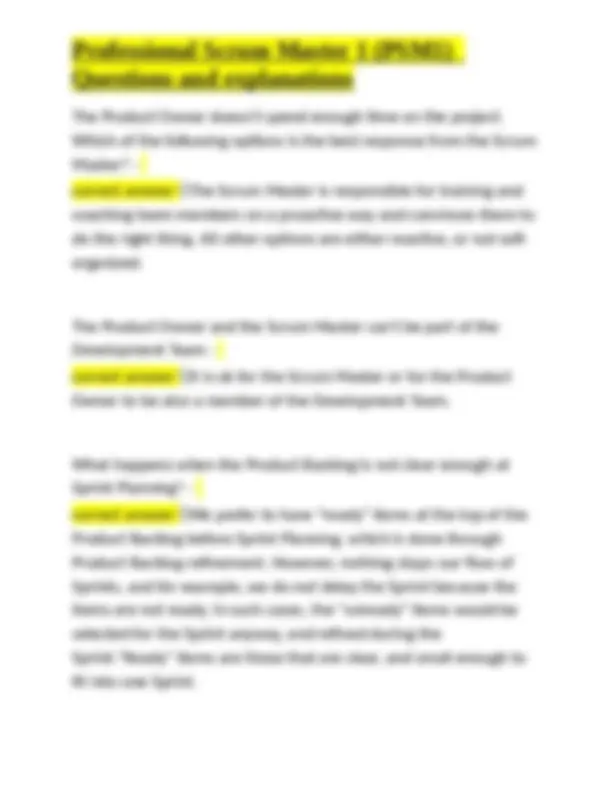
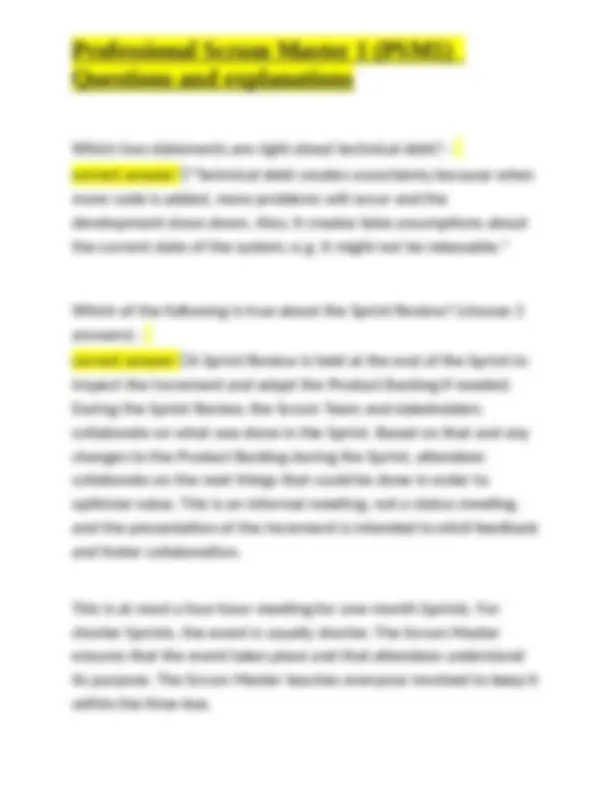
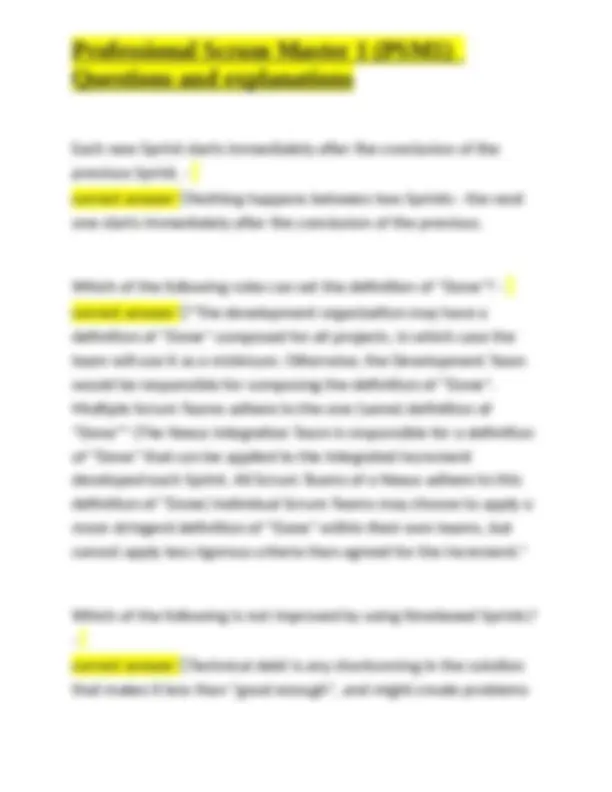
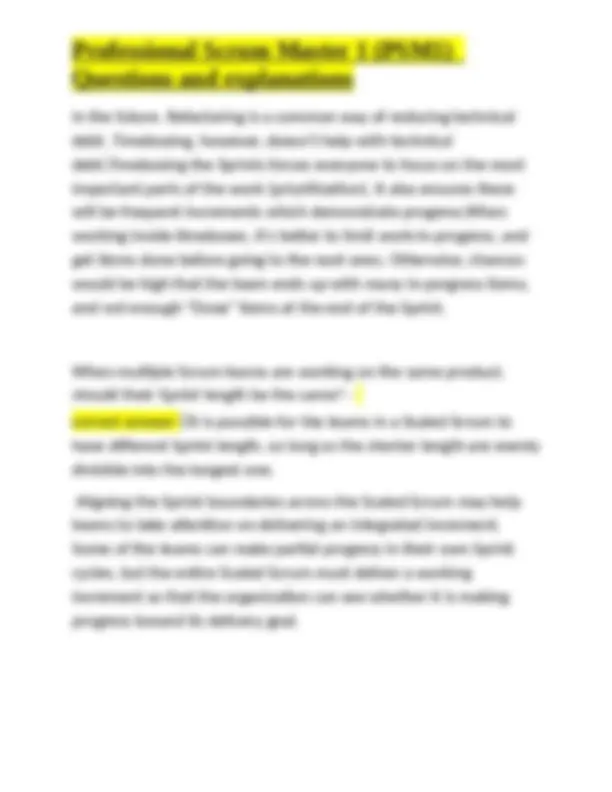
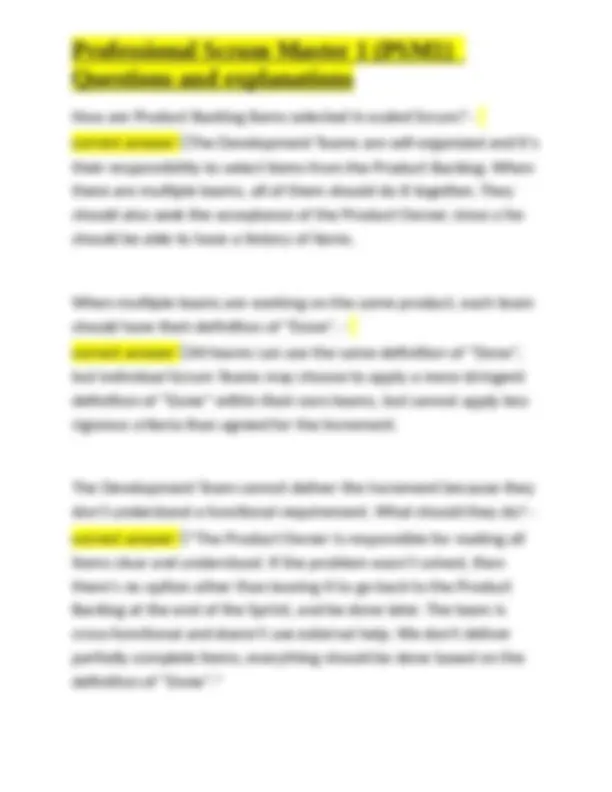
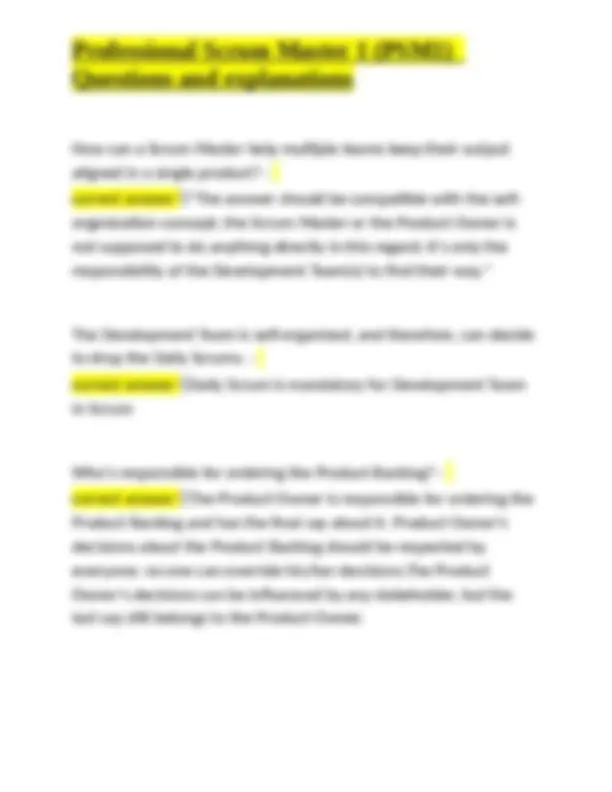
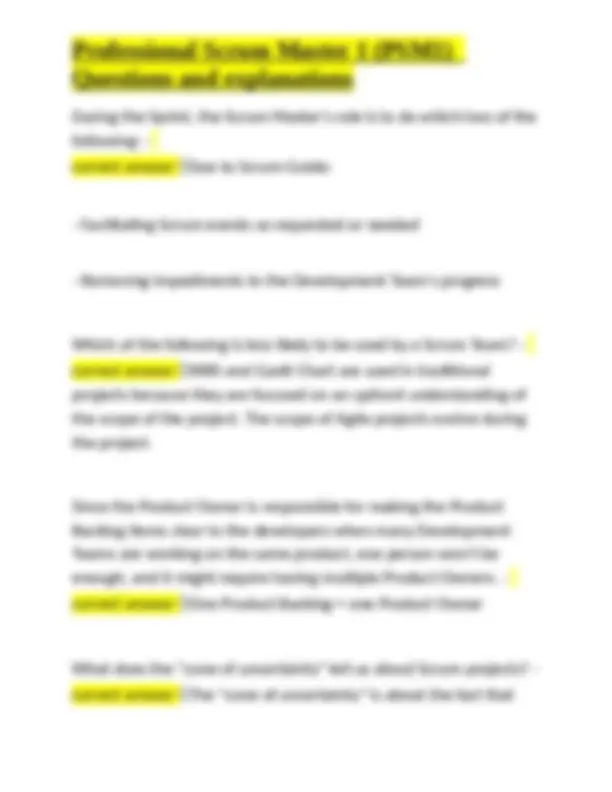
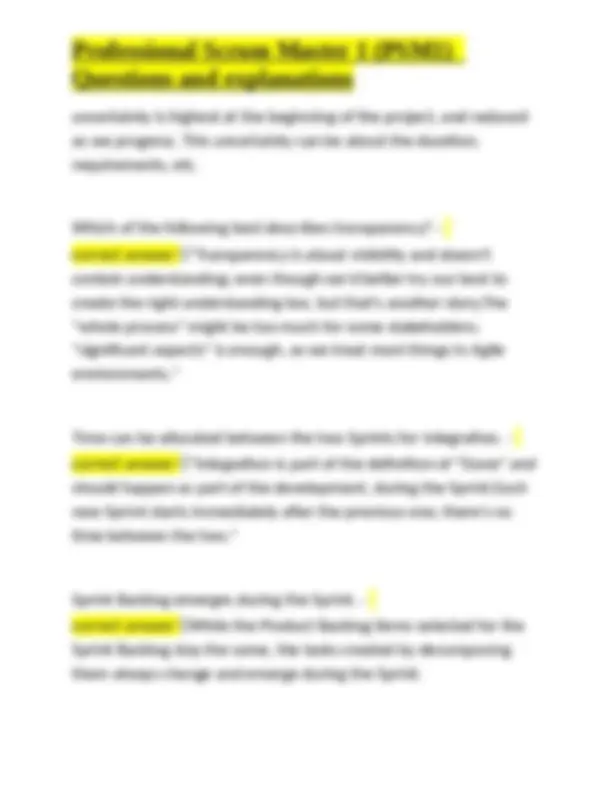
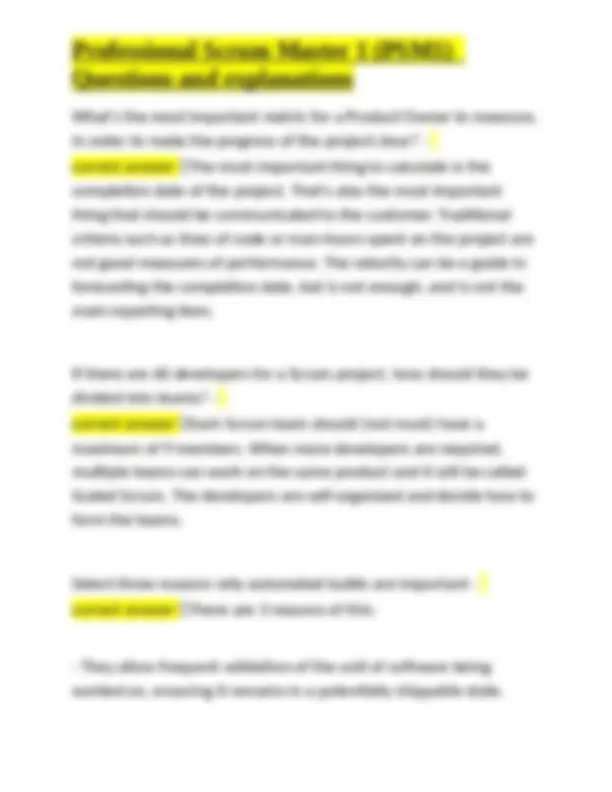
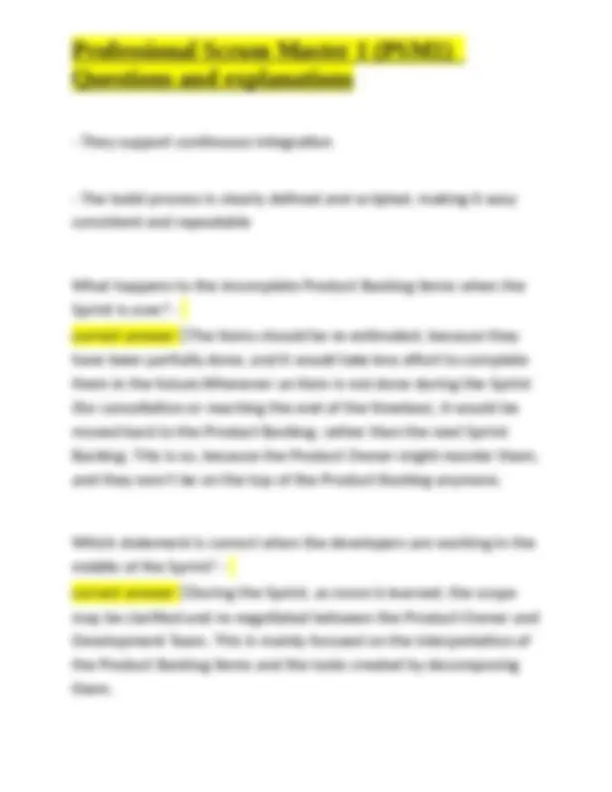
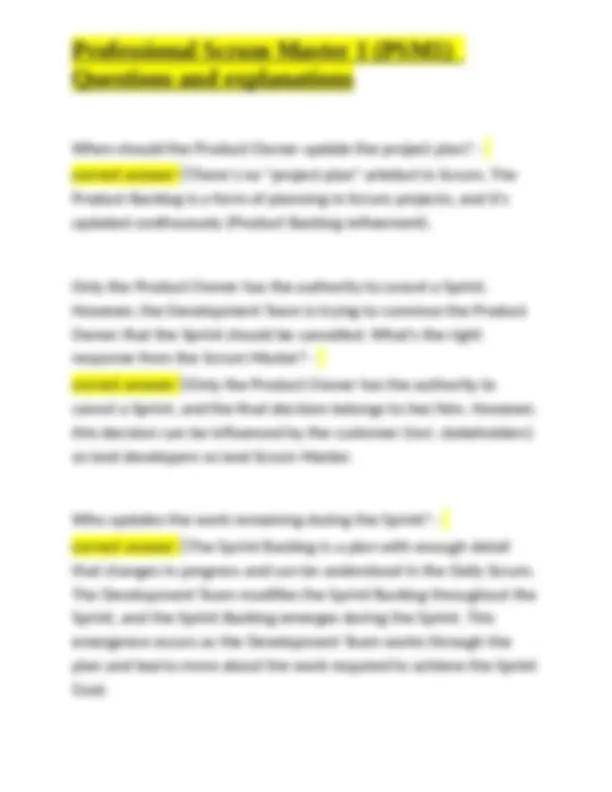
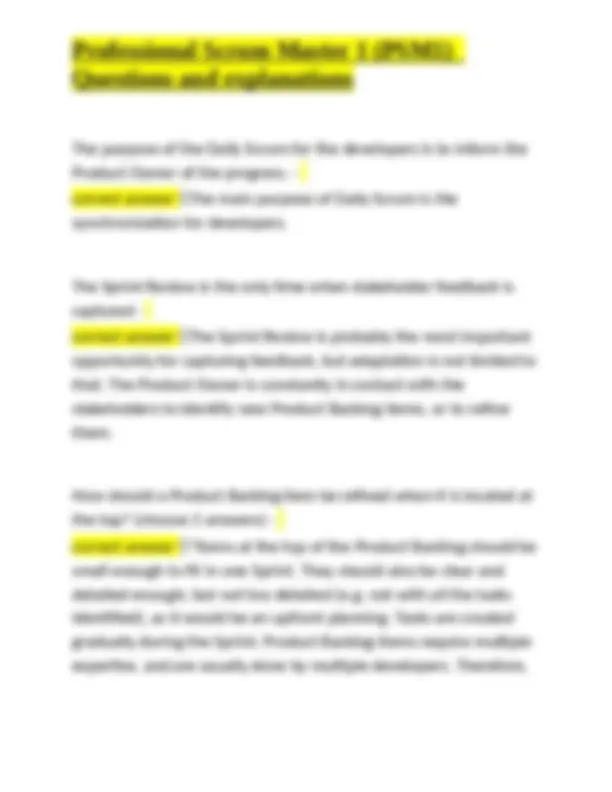
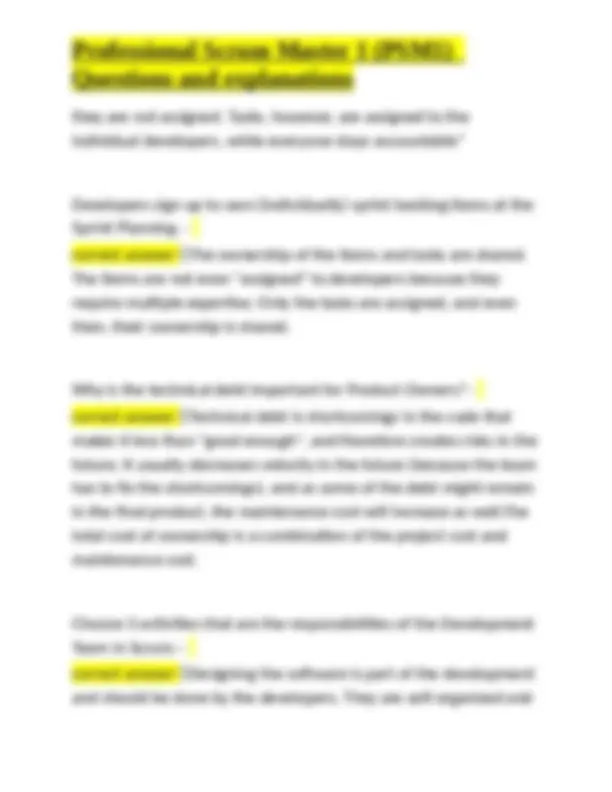
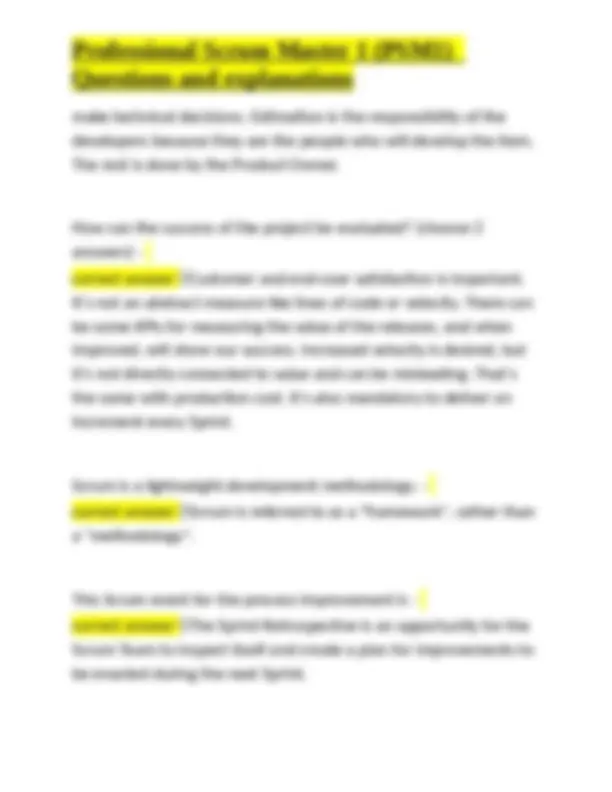
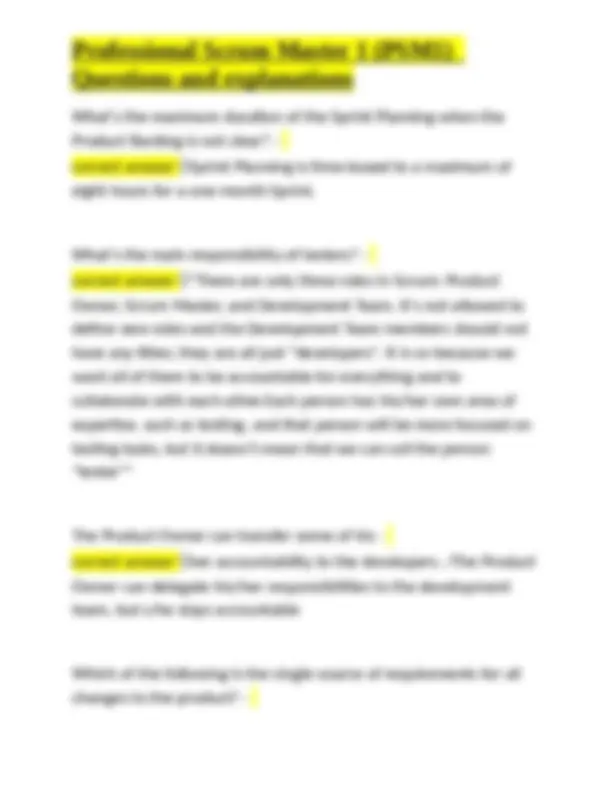
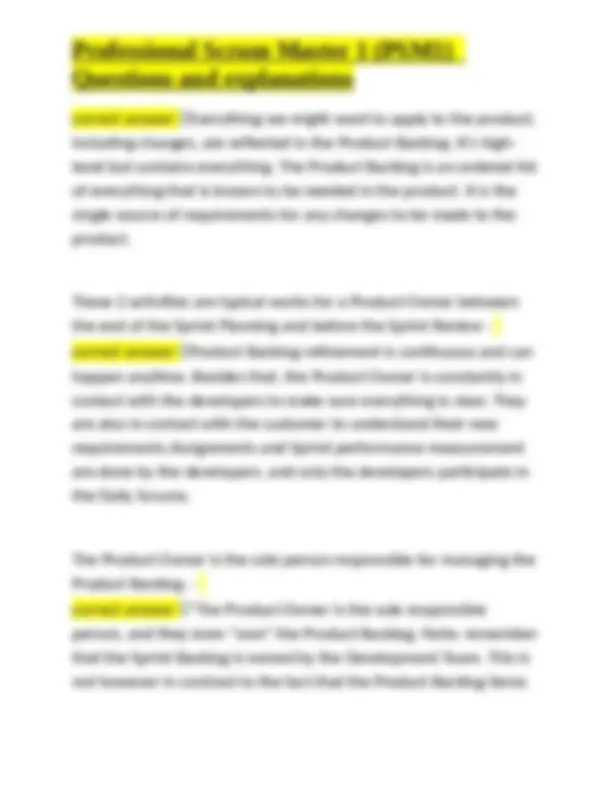
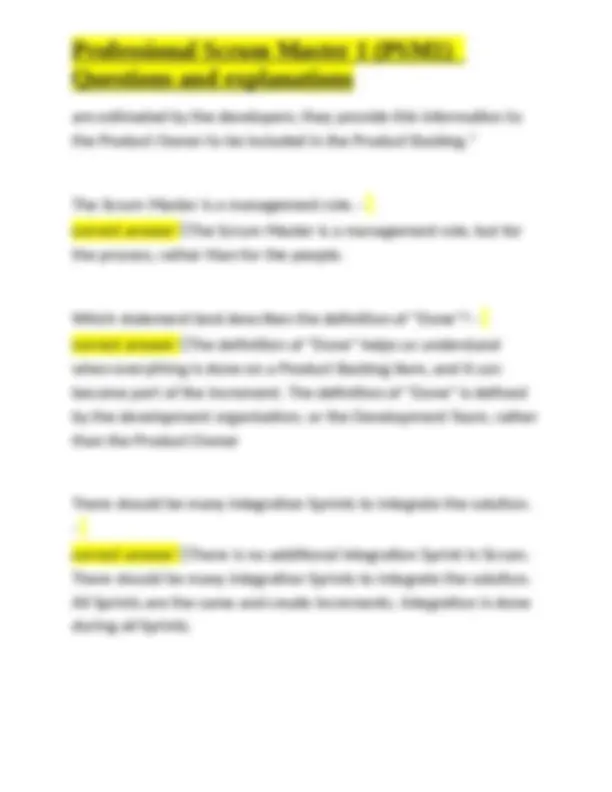
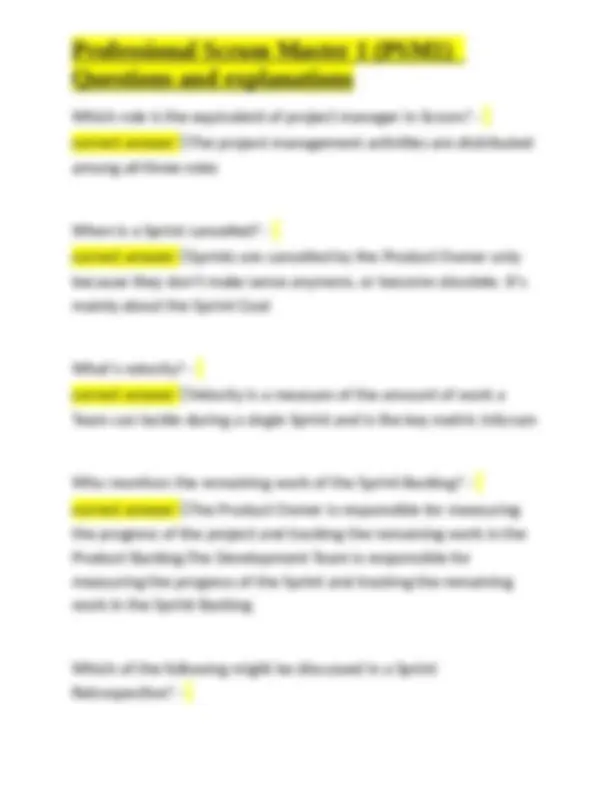
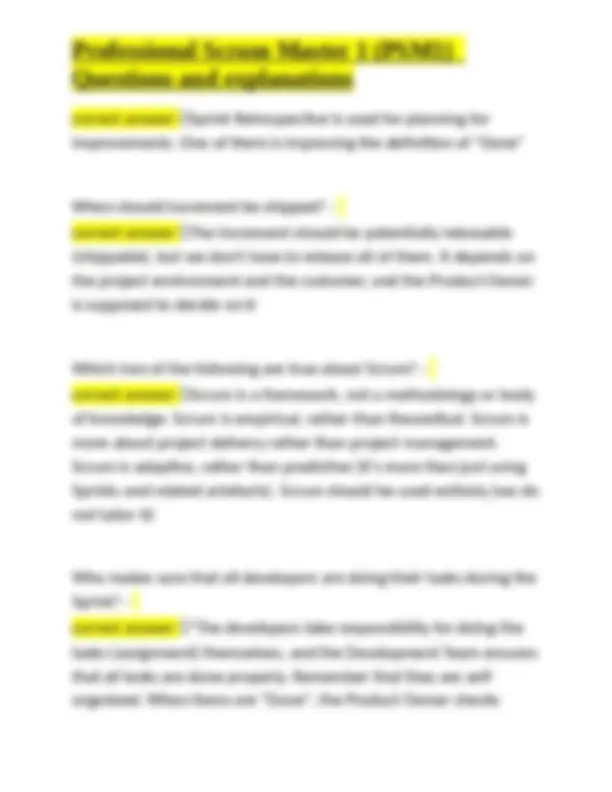
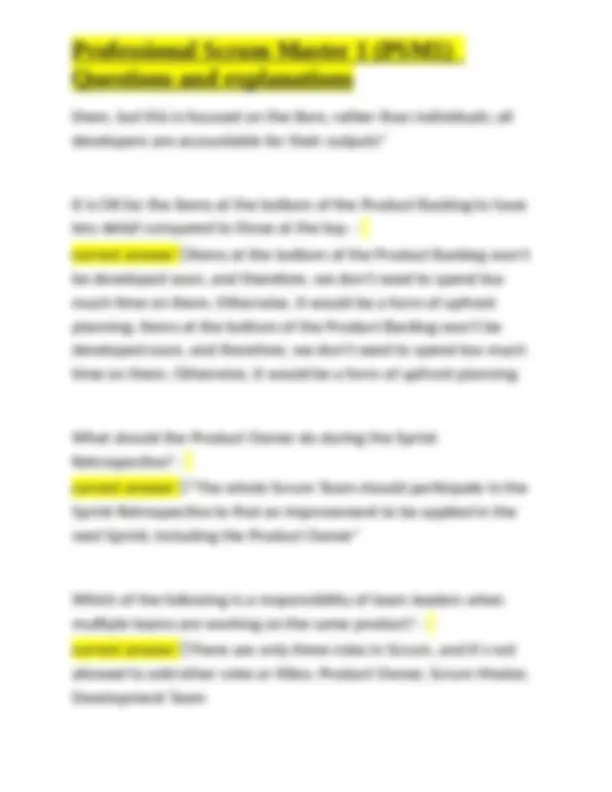
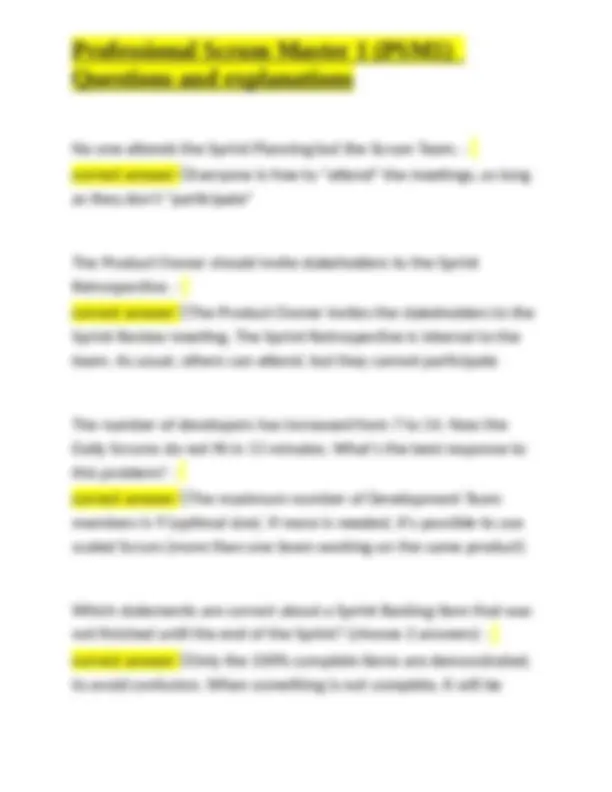
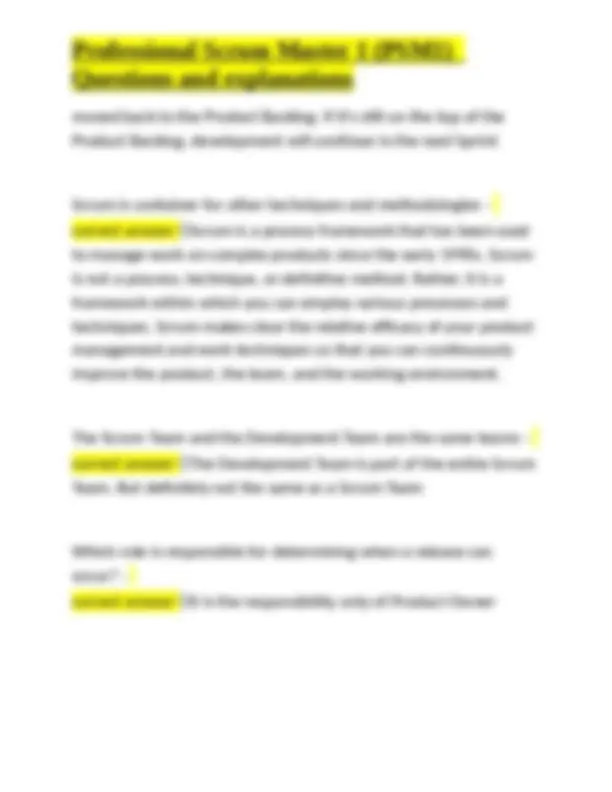
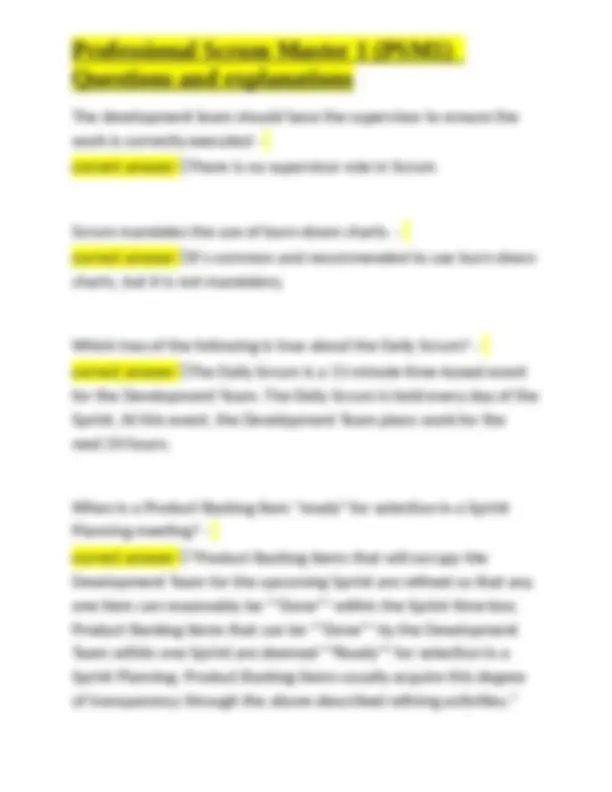
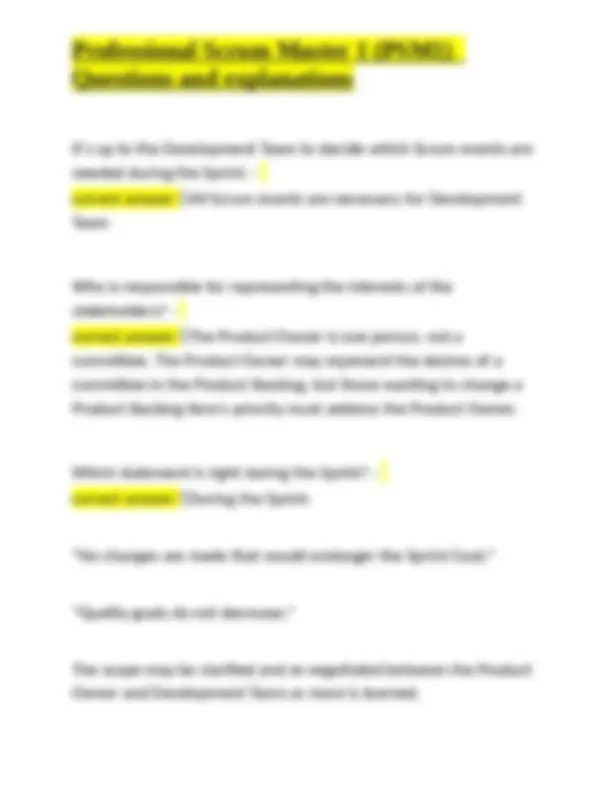
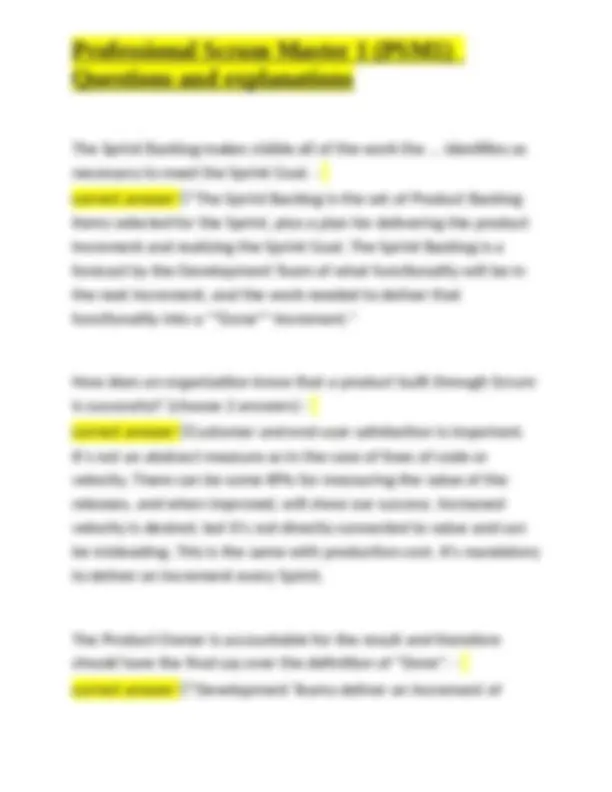
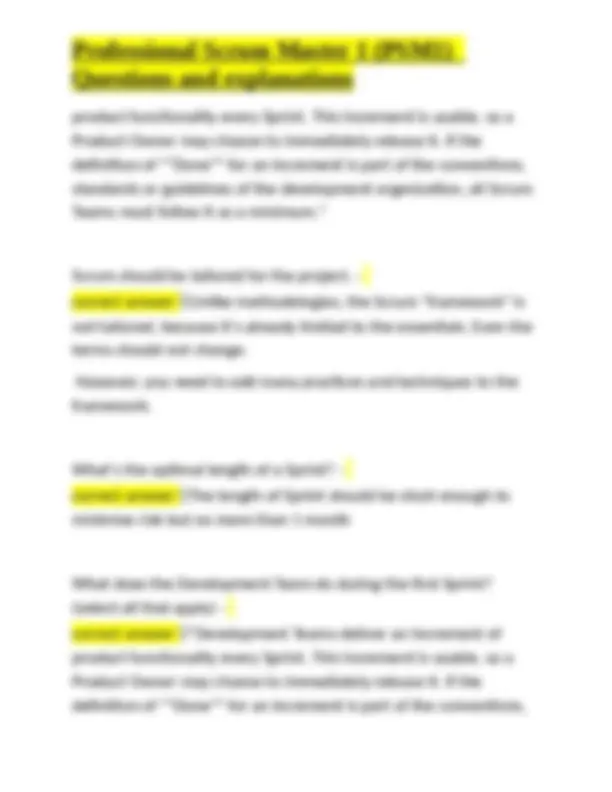
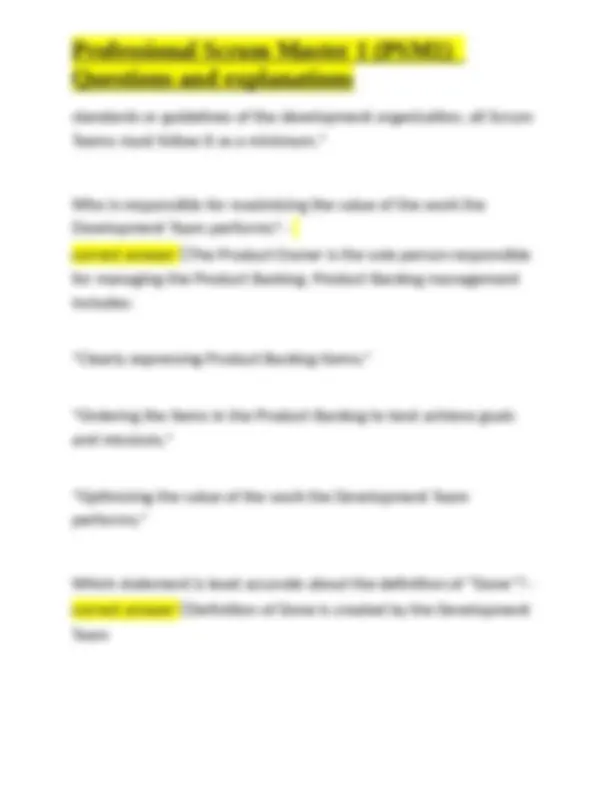
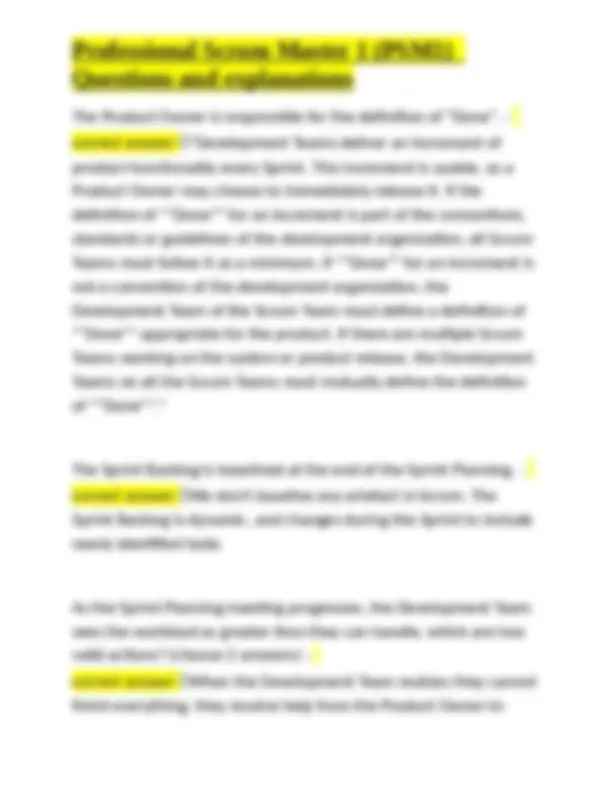
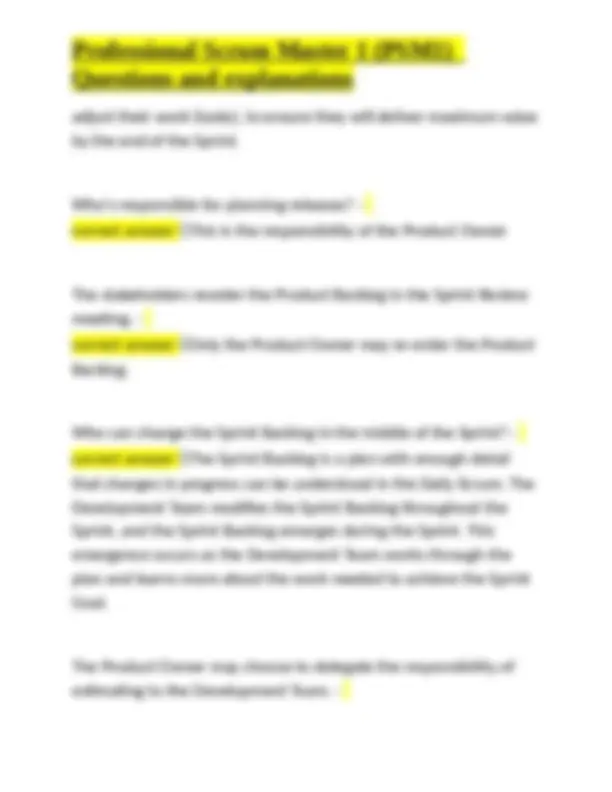
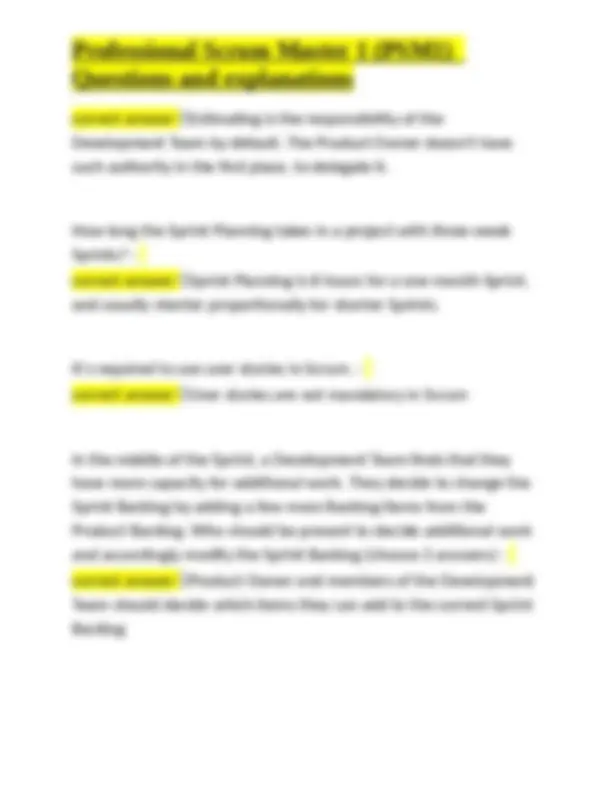
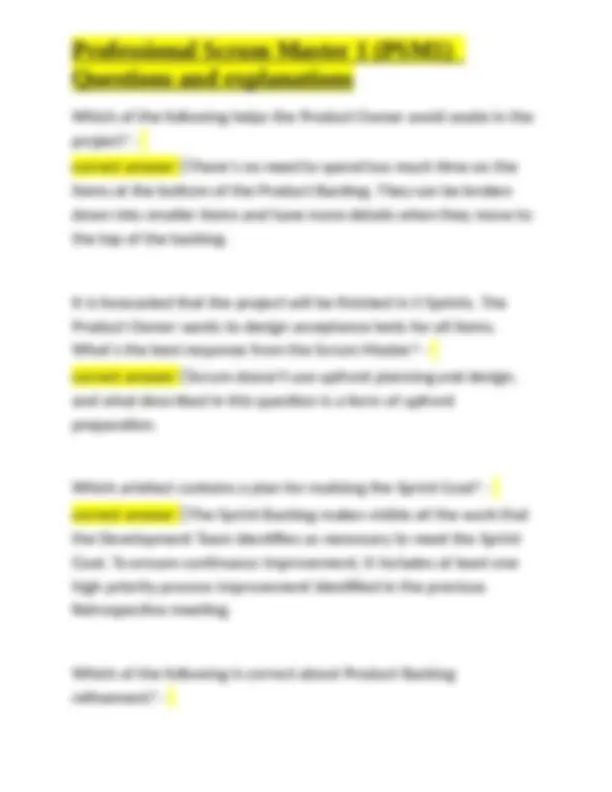
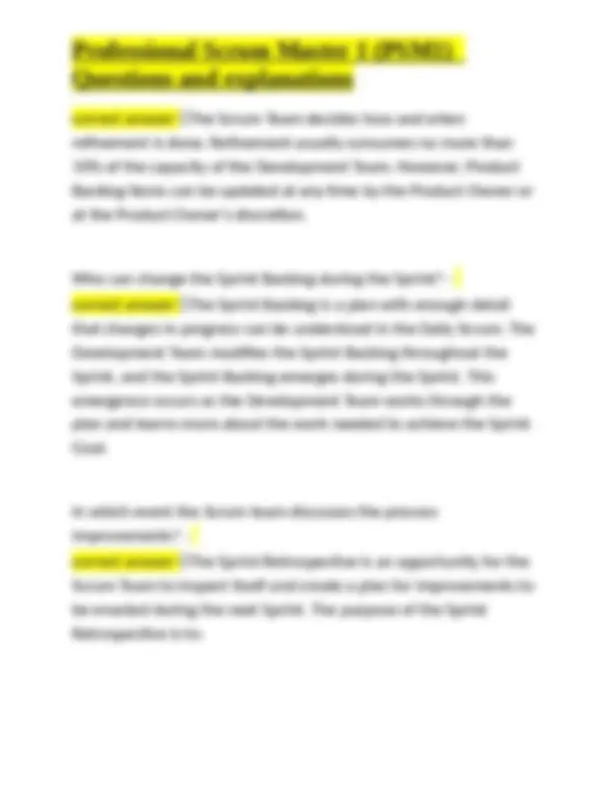
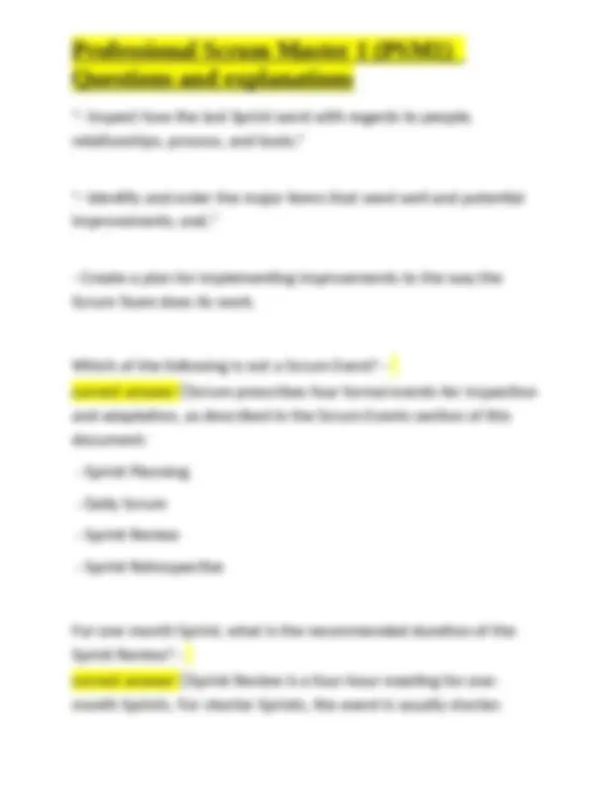
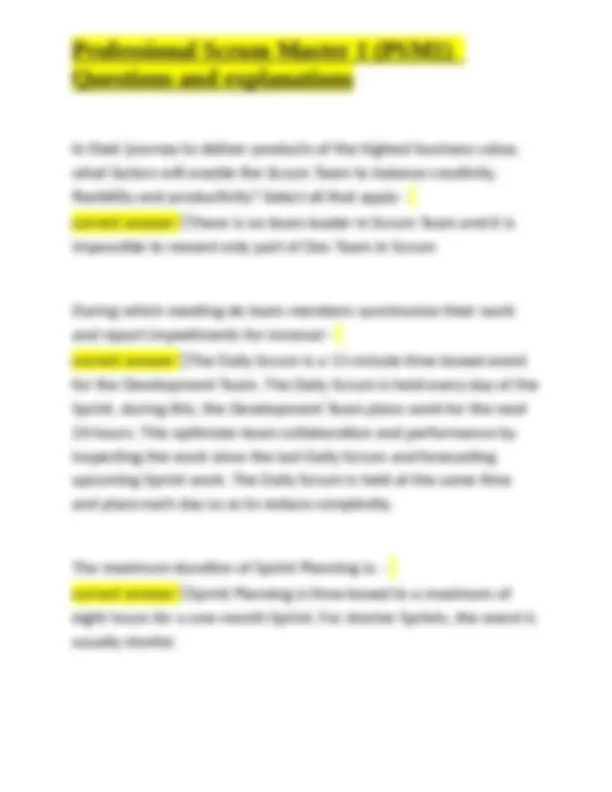
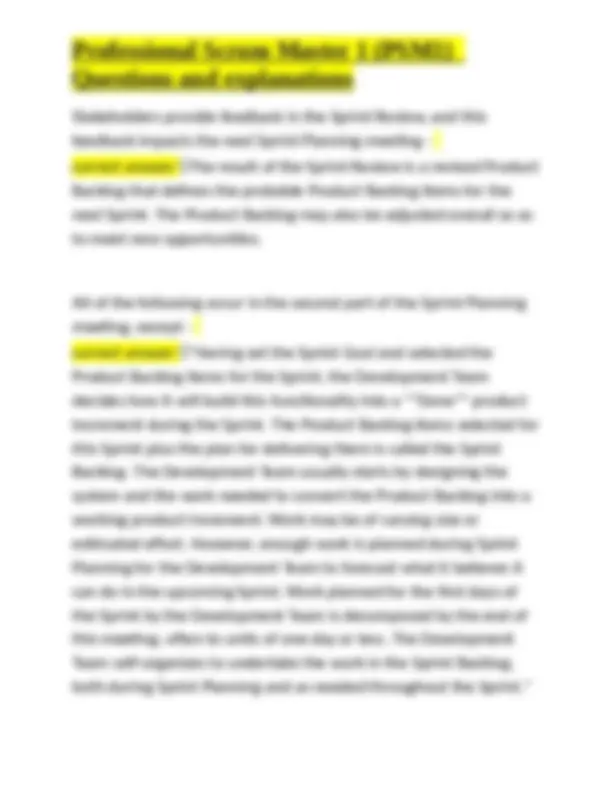
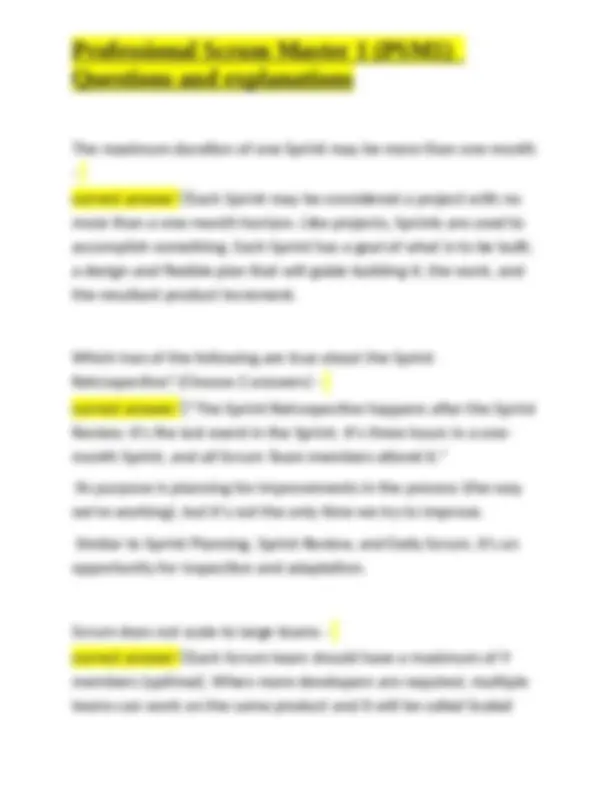
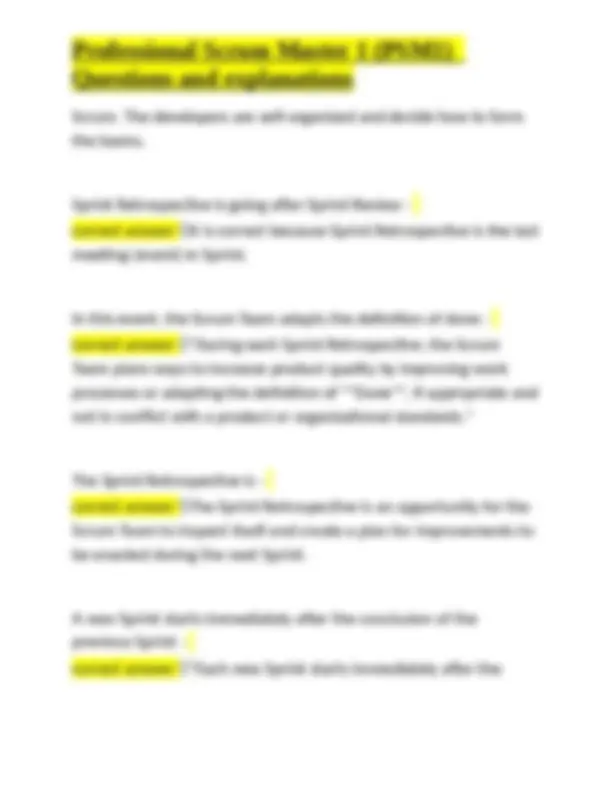
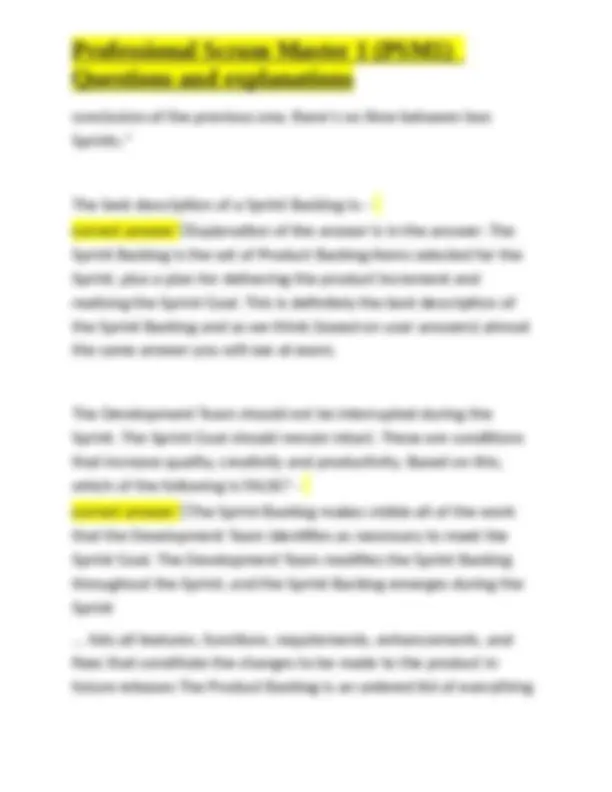
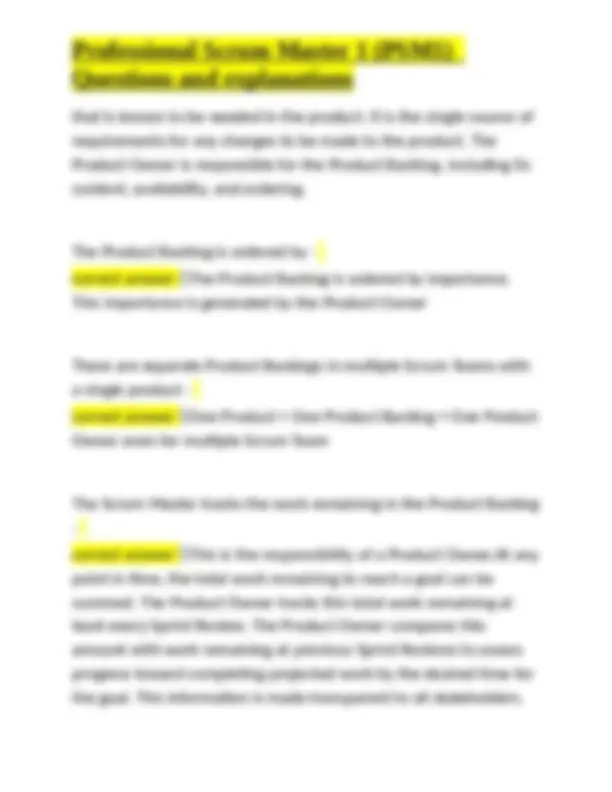
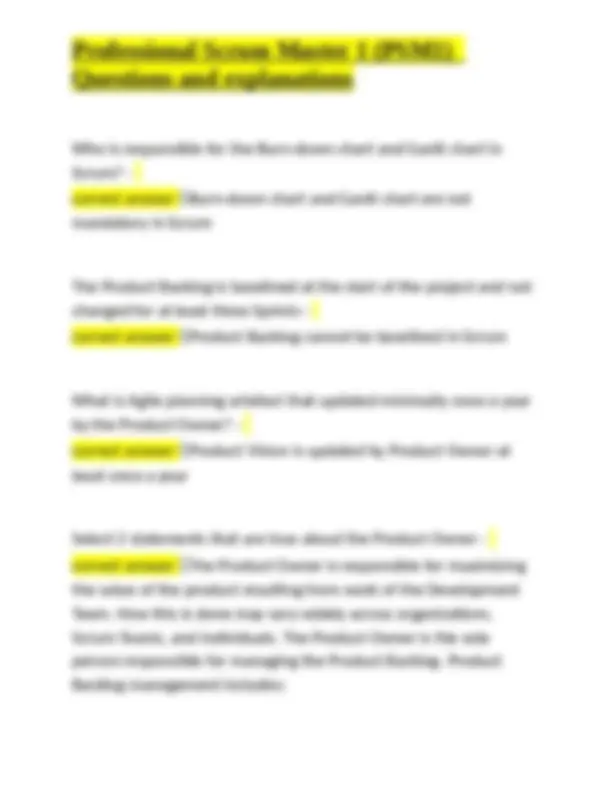
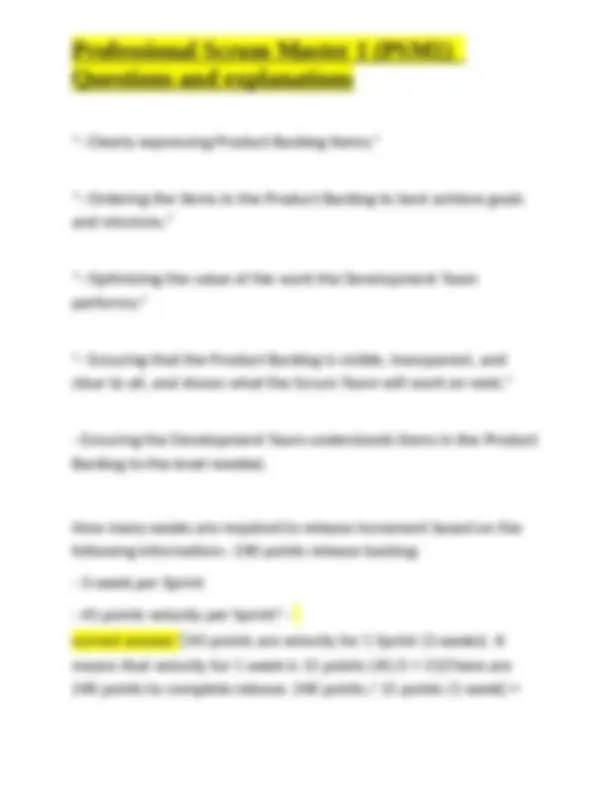


Study with the several resources on Docsity

Earn points by helping other students or get them with a premium plan


Prepare for your exams
Study with the several resources on Docsity

Earn points to download
Earn points by helping other students or get them with a premium plan
Community
Ask the community for help and clear up your study doubts
Discover the best universities in your country according to Docsity users
Free resources
Download our free guides on studying techniques, anxiety management strategies, and thesis advice from Docsity tutors
Professional Scrum Master 1 (PSM1) Questions and explanations
Typology: Exams
1 / 112

This page cannot be seen from the preview
Don't miss anything!





























































































The purposes of the Sprint Retrospective are to (select three): - correct answer ✅The purposes of the Sprint Retrospective are to: "- Inspect how the last Sprint went with regards to people, relationships, process, and tools;" "- Identify and order the major items that went well and potential improvements; and,"
A Servant leadership role includes - correct answer ✅One of the ways that the Scrum Master, as a servant leader, protects the team is by shielding it from interruptions. A cross-functional team in Scrum consists of what types of team members? - correct answer ✅The Scrum Team consists of a Product Owner, the Development Team, and a Scrum Master. Scrum Teams are self- organizing and cross-functional. Self-organizing teams choose how best to accomplish their work, rather than being directed by others outside the team. Cross-functional teams have all the competencies needed to accomplish the work without depending on others who are not part of the team. The team model in Scrum is designed to optimize flexibility, creativity, and productivity. The Scrum Team has proven itself to be increasingly effective for all the earlier stated uses and any complex work. The Product Owner and Scrum Master may be the part of the Development Team - correct answer ✅It's OK for the Product Owner and the Scrum Master to be in the Development Team
potentially releasable Increment. Having more than nine members requires too much coordination. Large Development Teams generate too much complexity for an empirical process to be useful. The Product Owner and the Scrum Master roles are not included in this count unless they are also executing the work of the Sprint Backlog. How should a Product Backlog item be refined before its development begins? (choose 2 answers) - correct answer ✅In a way that it's clear enough for the developers. In a way that it can be "Done" in the timeboxed duration of one Sprint. "Items at the top of the Product Backlog need to be small enough to fit into one Sprint. They also need to be clear and detailed enough; but not too detailed (e.g. not with all the tasks identified), as it would be upfront planning. Tasks are created gradually during the Sprint." Product Backlog items require multiple expertise, and usually done by multiple developers. Therefore, they are not assigned. Tasks, however, are assigned to the individual developers, while everyone stays accountable.
Who creates the Sprint Goal? - correct answer ✅The Sprint Goal is an objective set for the Sprint that can be met through the implementation of Product Backlog. It provides guidance to the Development Team on why it is building the Increment. It is created during the Sprint Planning meeting. The Sprint Goal gives the Development Team some flexibility regarding the functionality implemented within the Sprint. The selected Product Backlog items deliver one coherent function, which can be the Sprint Goal. The Sprint Goal can be any other coherence that causes the Development Team to work together rather than on separate initiatives. The Scrum Master shouldn't allow the Development Team to start developing without having the tasks identified and assigned. - correct answer ✅There are two problems with this statement:1. The Scrum Master doesn't manage people and cannot forbid team members from doing something and cannot order them to do certain things. S/he should always "convince" them to do the right thing by training and coaching.2. The Development Team identifies the tasks and assigns them gradually, throughout the Sprint. We don't do it upfront, at the beginning of the Sprint. Which of the following describes the definition of "Done"? (choose 2 answers) -
The Product Backlog is only refined during the Sprint Planning and Sprint Review. - correct answer ✅Product Backlog refinement is the act of adding detail, estimates, and order to items in the Product Backlog. This is an ongoing process in which the Product Owner and the Development Team collaborate on the details of Product Backlog items. During Product Backlog refinement, items are reviewed and revised. The Scrum Team decides how and when refinement is done. Refinement usually consumes no more than 10% of the capacity of the Development Team. However, Product Backlog items can be updated at any time by the Product Owner or at the Product Owner's discretion. Which of the following is the most important opportunity for capturing lessons learned? - correct answer ✅Lessons learned are always captured, but the main purpose of Sprint Retrospective is capturing and planning for lessons learned. The purpose of the Sprint Retrospective is to: "Inspect how the last Sprint went with regards to people, relationships, process, and tools;"
"Identify and order the major items that went well and potential improvements;" Create a plan for implementing improvements to the way the Scrum Team does its work. Which one of the following statements is correct when multiple Scrum teams are working on the same product? - correct answer ✅There's only one Product Backlog for Scrum Team. "One" project and "one" product has only "one" Product Backlog and "one" Product Owner. Otherwise, prioritization and accountability would be difficult. Pick 3 activities that are the accountability of the Development Team - correct answer ✅Designing the software is part of the development and should be done by the developers. They are self-organized and make technical decisions. Estimation is the responsibility of the developers because they are the people who will develop the item. The rest is done by the Product Owner. How should the Product Owner forecast the completion date? - correct answer ✅Using a trend line in the burn-down chart can help (if the team is using that chart), as well as simple or complex
just enough to show what the development team is going to do in the next few days. The rest of the tasks will be created during the Sprint." Hardening Sprints are helpful for defect management and integration. - correct answer ✅There are no hardening Sprints in Scrum. All Sprints are the same and create Increments."Hardening" is done during all Sprints. Which item is NOT an attribute of the Product Backlog? - correct answer ✅Each Product Backlog has a description (e.g. in the "user story" format), a business value used for ordering, and an estimate of the amount of effort. Is Sprint Review a formal meeting? - correct answer ✅Sprint review is a formal event, but informal meeting Who determines when it's time to update the Sprint Backlog during the Sprint? - correct answer ✅The Sprint Backlog includes the items selected
from the Product Backlog and the tasks created by decomposing the items. Only the tasks are updated during the Sprint, and it's the Development Team's responsibility to do so. Who's in the Scrum Team? (Choose multiple answers) - correct answer ✅The Scrum Team consists of a Product Owner, the Development Team, and a Scrum Master. Which of the following is done in the first Sprint? - correct answer ✅There's no difference between the first Sprint and the next ones. The main purpose is creating Increments. A Development Team member should own each Sprint Backlog item. - correct answer ✅The Development Team owns the Sprint Backlog, not separate members of the team. The Product Owner does not have to be one person, and the role can be played by a committee. - correct answer ✅It's possible to have a committee responsible for product ownership, but only a representative of that committee
that shouldn't be changed during the Sprint are those required for keeping them focused on their development." How can the size of items on the Sprint Backlog be compared to the average size of Product Backlog items? - correct answer ✅Often (In most cases) Product Backlog Items are split and get smaller over time before they reach the Sprint Backlog. Due to this, in general Sprint Backlog items are smaller than Product Backlog items. "However, a Sprint Backlog Item can be seen as a Product Backlog Item plus a plan for implementing it. In that sense it is additive to, and thus ""larger"" than, the selected Product Backlog Items." But, as we think the first case is related to PSM 1 exam. When forming multiple Scrum teams, which two of the following are the most important considerations? - correct answer ✅All teams should be cross-functional, with optimal size 3 to 9 members. Also, it is very important for teams to avoid dependencies on each other as much as it possible. What is the best description of the job of a Product Owner? - correct answer ✅All items are less or more applicable, but
remember that the main responsibility of the Product Owner is to maximize value, and "working with stakeholders to identify the most important requirements" is the closest answer to "increasing value". What are some consequences if a Development does not have a consistent Definition of Done from Sprint to Sprint? - correct answer ✅All answers are correct The Product Owner actively asks for stakeholder input into the Product Backlog However, a Product Owner is the only person who is responsible for Product Backlog he - correct answer ✅she actively asks for stakeholder input into the Product Backlog Which of the following are optional in Scrum? (choose 2 answers) - correct answer ✅Velocity calculations and the use of burn-down charts are common and recommended, but not mandatory. The rest are Scrum artifacts. All Scrum roles, events, and artifacts are mandatory.
Which statement is not true about the Scrum? " - correct answer ✅A Product Backlog is never complete. The earliest development of it lays out the initially known and best-understood requirements. The Product Backlog evolves as the product and the environment in which it will be used evolves. The Product Backlog is dynamic; it constantly changes to identify what the product needs to be appropriate, competitive, and useful. If a product exists, its Product Backlog also exists. Due to this requirements cannot be static" Which of the following is not a prioritisation technique? - correct answer ✅Planning poker, also called Scrum poker, is a consensus-based, gamified technique for estimating, mostly used to estimate effort or relative size of development goals in software development. In planning poker, members of the group make estimates by placing numbered cards face-down on the table, instead of saying them aloud. The cards are revealed, and the estimates are then discussed. By hiding the figures in this way, the group can avoid the cognitive bias of anchoring, where the first number spoken aloud sets a precedent for subsequent estimates. Planning Poker is not a prioritisation technique
Software dependencies can influence how the Product Owner orders Product Backlog items - correct answer ✅"Software dependencies may really influence PBI ordering. It doesn't mean the Product Owner must always order the PBI by referring to software dependencies, but the question is ""can"" instead of ""must"". Maybe it is not very good practice but it is up to the Product Owner to decide if this factor is important for ordering the items or not. So it can be one of the reasons to re- order the item. This is one of many so-called ""confusing"" questions in the real exam." Development team members sign up to own Product backlog items at the Sprint Planning - correct answer ✅The only one owner of the Product Backlog (include Product Backlog items) is the Product Owner A new task to complete the Sprint Goal is identified after the Sprint Planning. When will this task be added to the Sprint Backlog? - correct answer ✅The Sprint Backlog is a plan with enough detail that changes in progress can be understood in the Daily Scrum. The Development Team modifies the Sprint Backlog throughout the Sprint, and the Sprint Backlog emerges during the Sprint. This emergence occurs as the Development Team works through the
known and best-understood requirements. The Product Backlog evolves as the product and the environment in which it will be used evolves. The Product Backlog is dynamic; it constantly changes to identify what the product needs to be appropriate, competitive, and useful. If a product exists, its Product Backlog also exists." In Scrum, the Product Owner is accountable for ..... - correct answer ✅The Product Owner is the sole person responsible for managing the Product Backlog. Product Backlog management includes: "- Clearly expressing Product Backlog items;" "- Ordering the items in the Product Backlog to best achieve goals and missions;" "- Optimizing the value of the work the Development Team performs;" "- Ensuring that the Product Backlog is visible, transparent, and clear to all, and shows what the Scrum Team will work on next;"